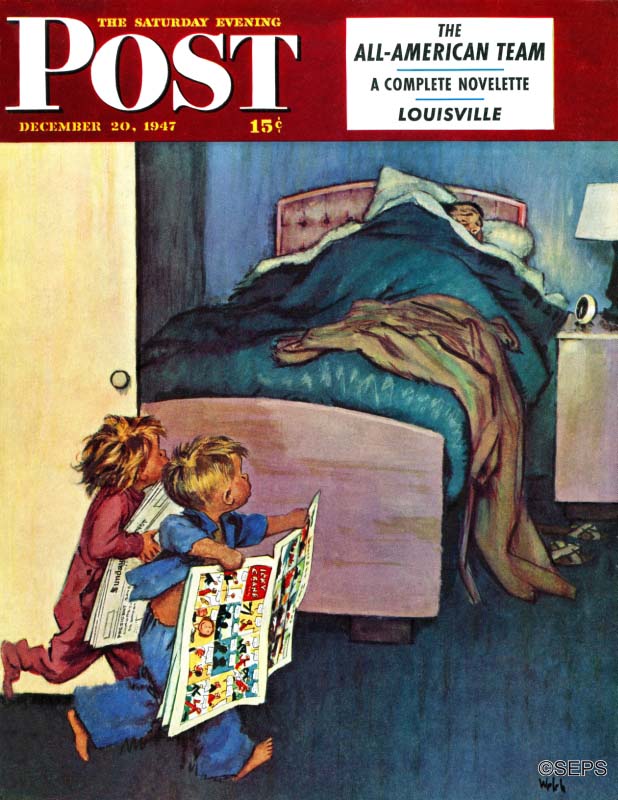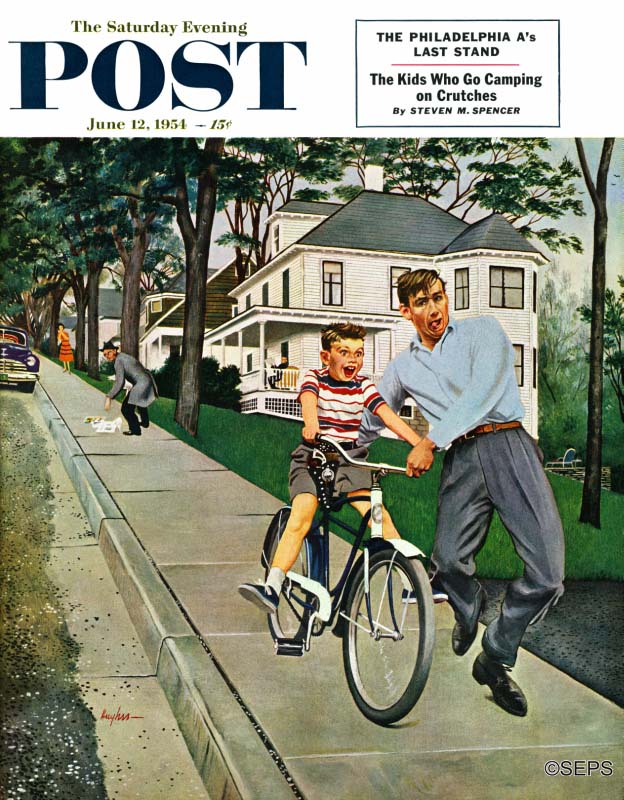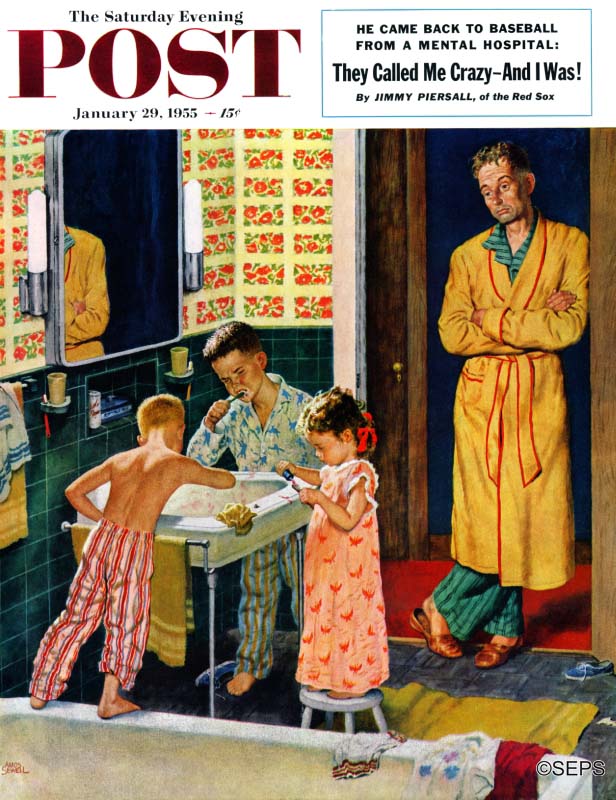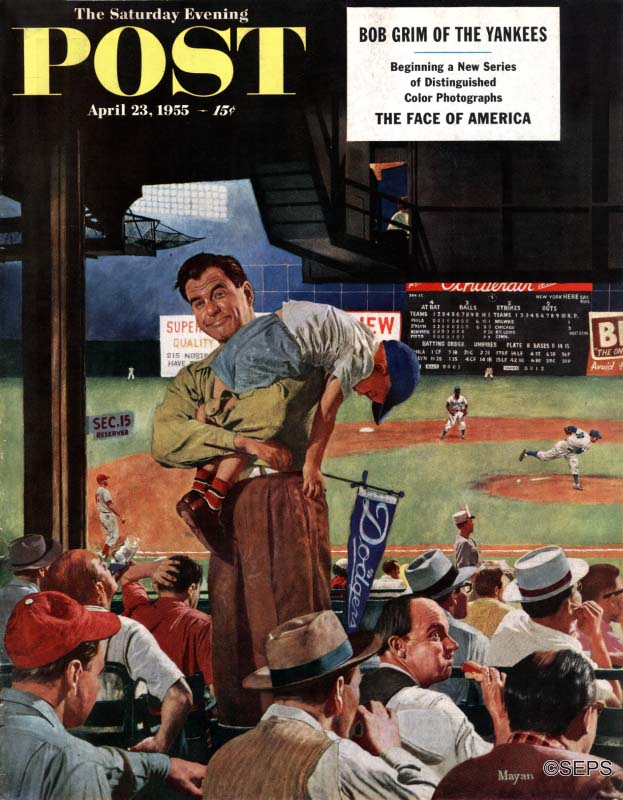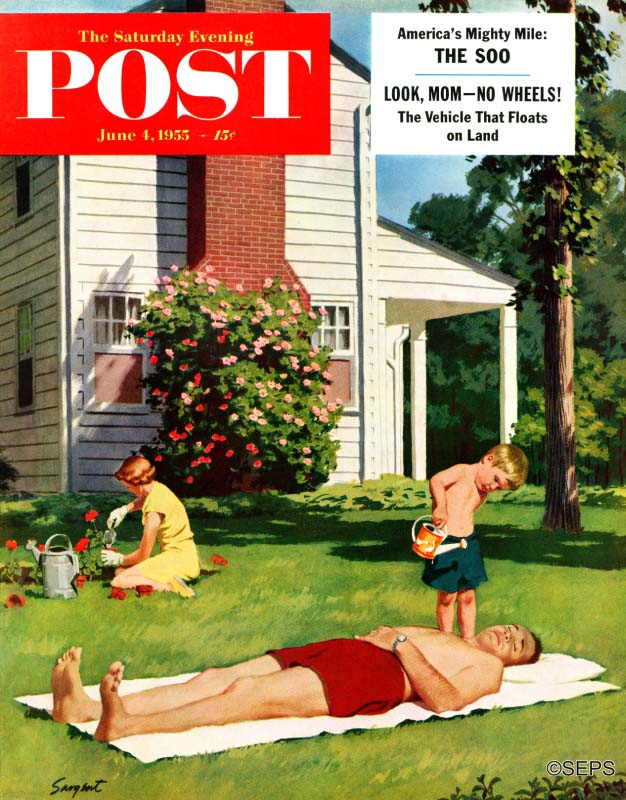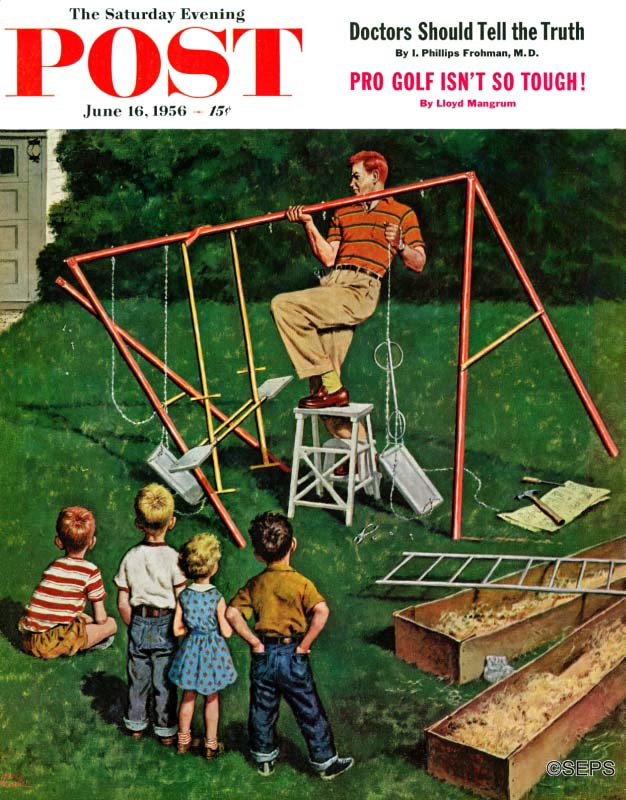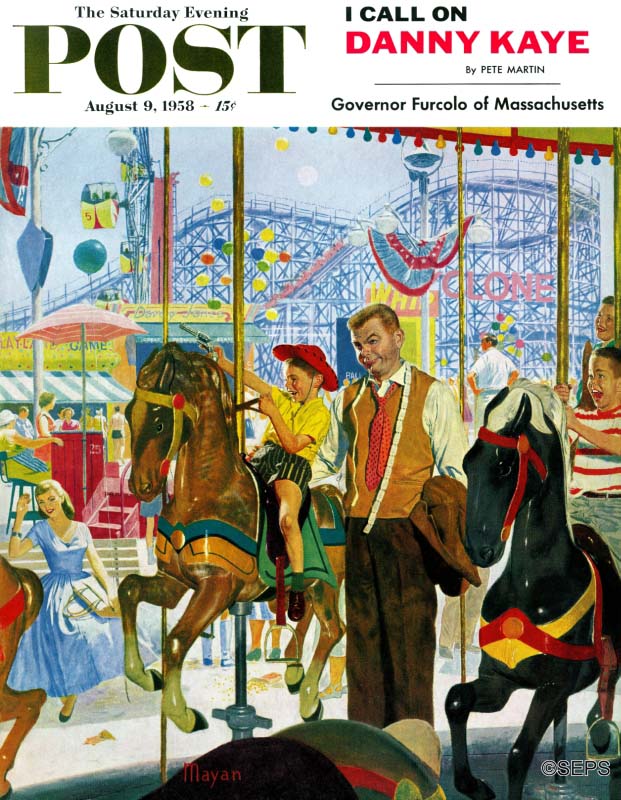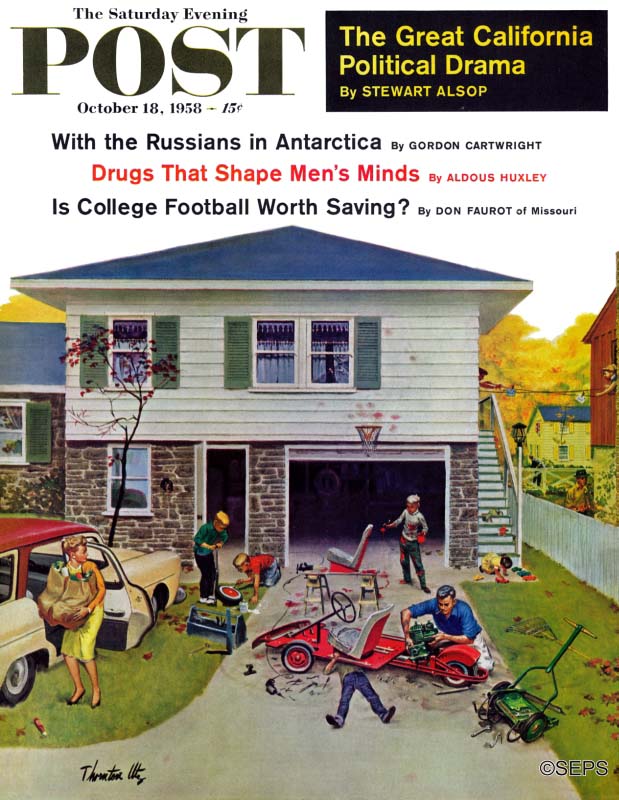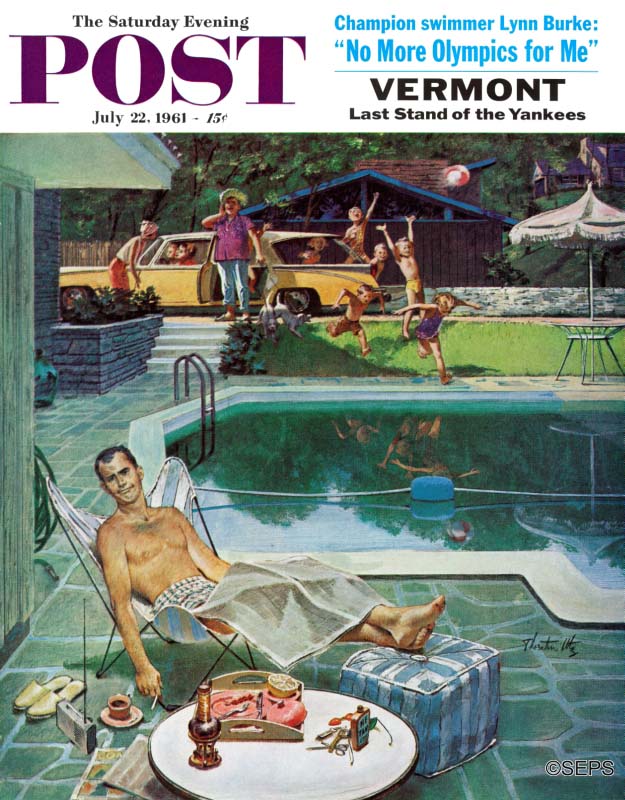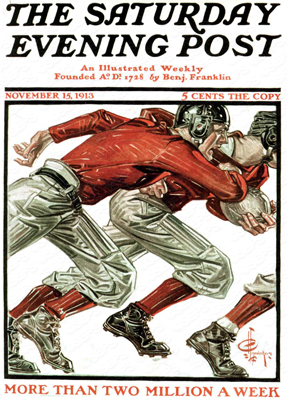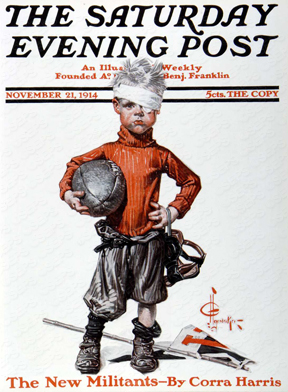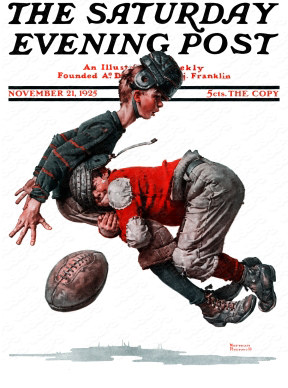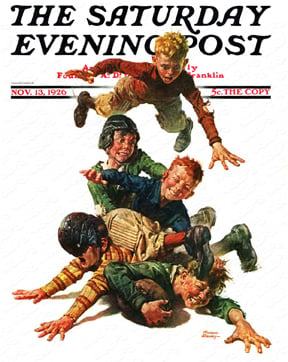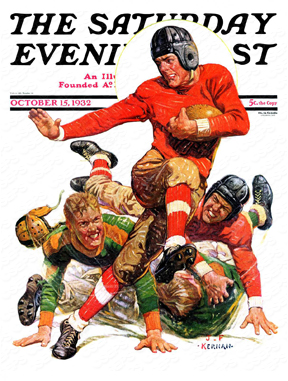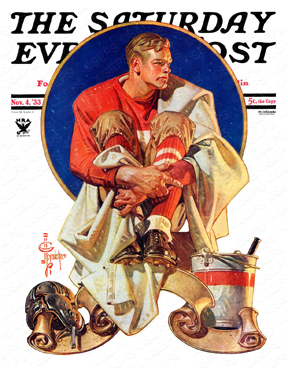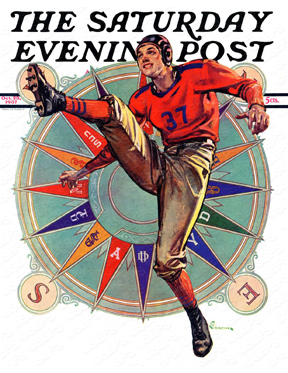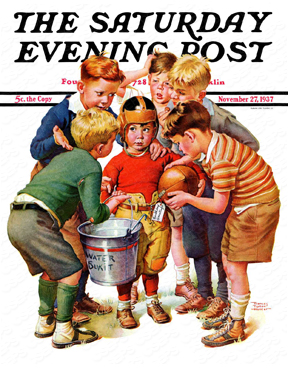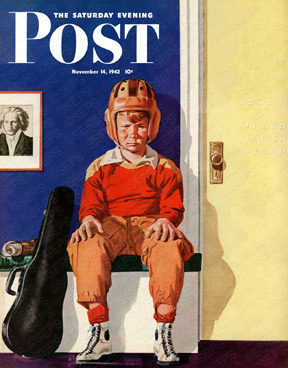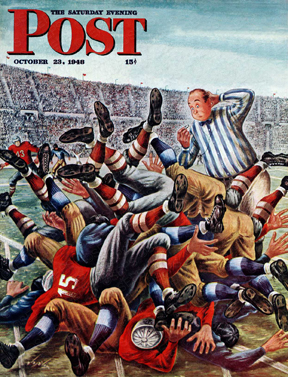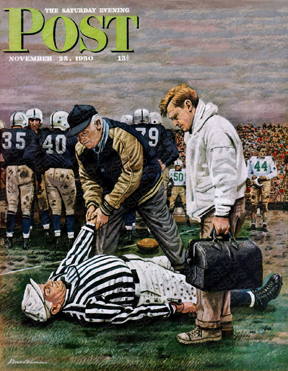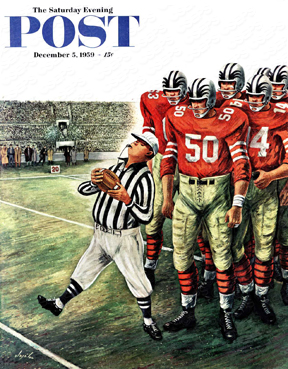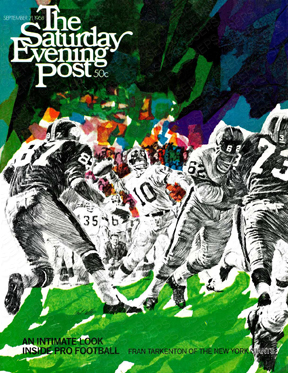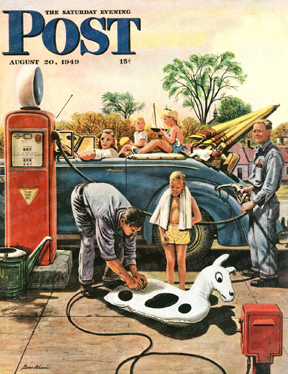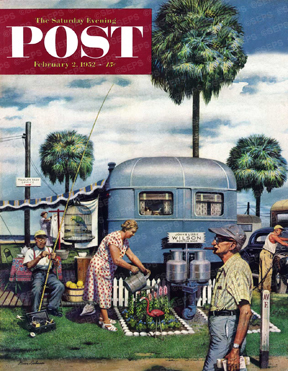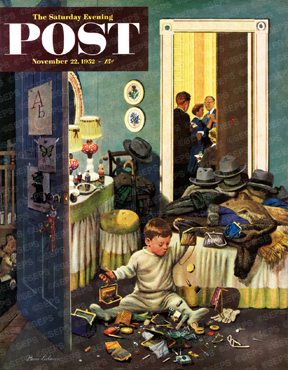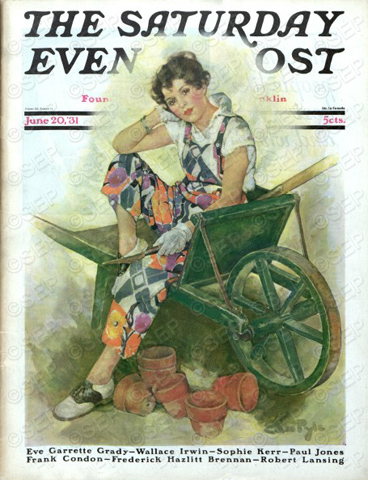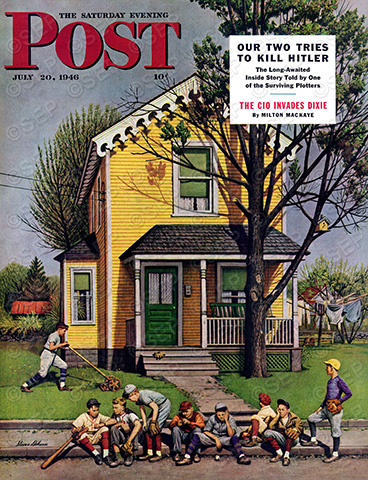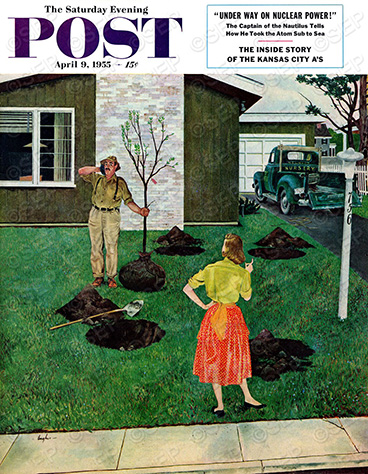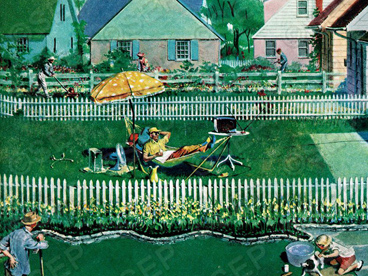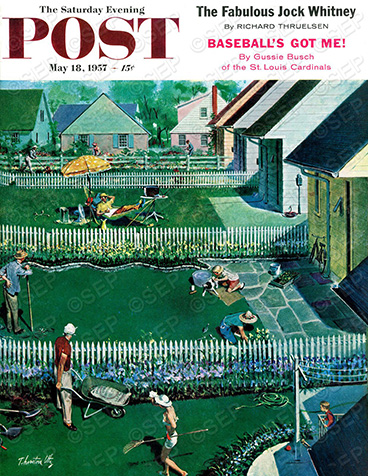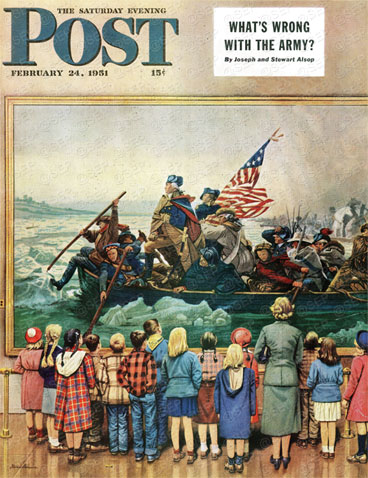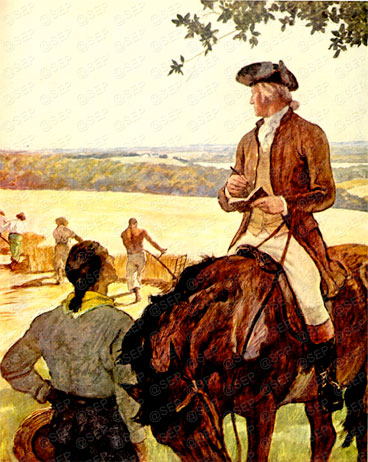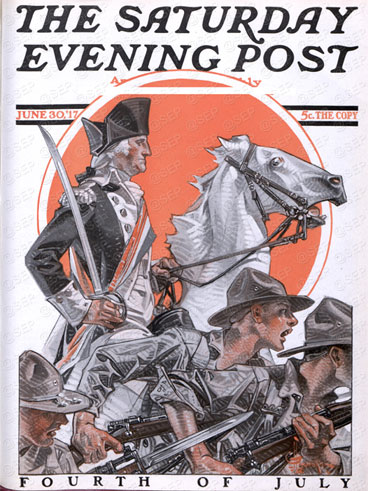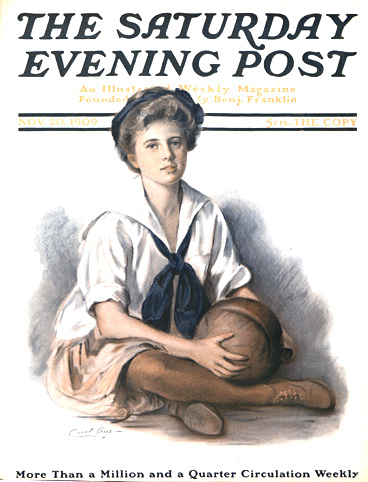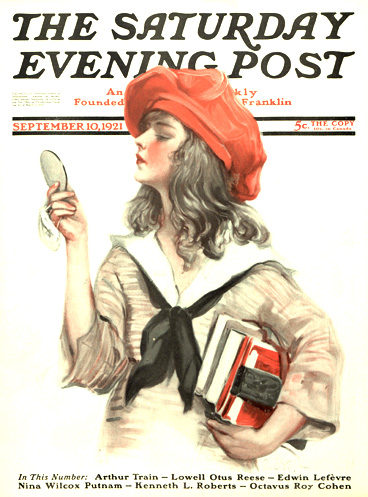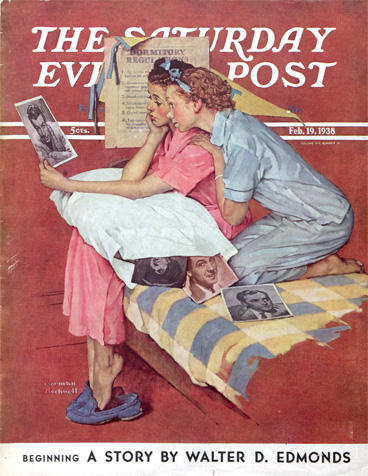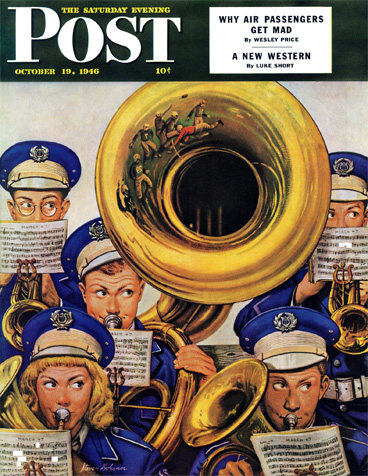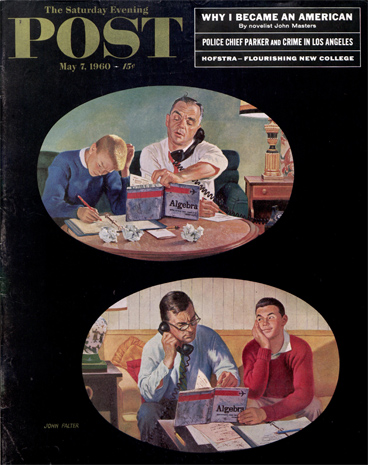Just Beachy
Celebrate a century of beachgoing with these sun-sational covers. You might have sand in your shoes for a week afterward, but that’s a small price to pay.
For guys and gals alike, sharp style is a must to complement even the most radiant bronzed glow.
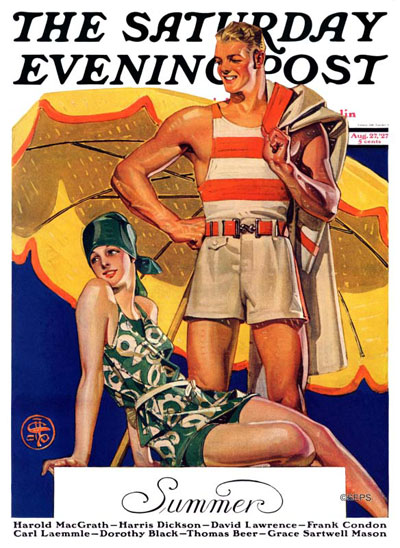
August 27, 1927
Armed with trusty life preserver, the guard holds court over his sun-toasted subjects with all the regality of a king and twice the jawline.
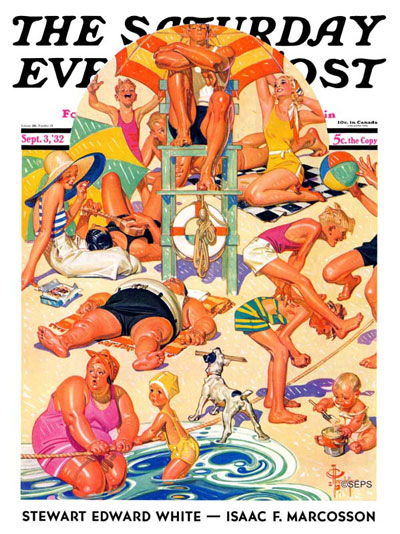
September 3, 1932
Et tu, ice cream? Getting lost in a spiraling forest of umbrellas isn’t especially ideal when you’ve got cool treats on hand rapidly turning to Neapolitan soup.
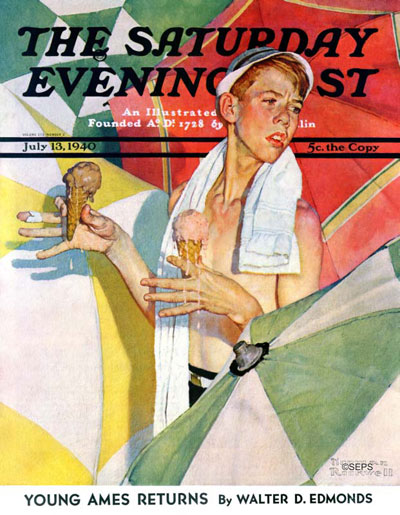
July 13, 1940
A prayer for some cloud cover might be in order if this ghostly couple wants to remain distinguishable from overcooked lobsters by day’s end.
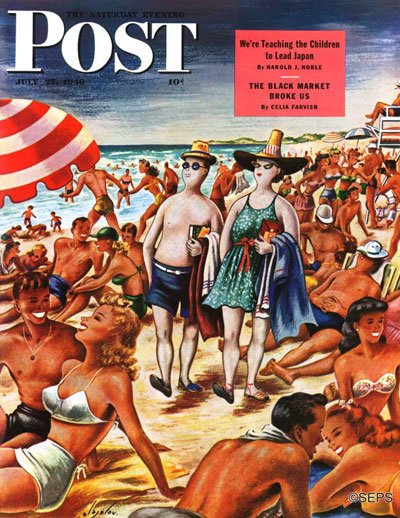
July 27, 1946
The tugboat may capsize when the tide arrives, but for one new to the sights and smells of the seaside, witnessing the frothy waves curl into the sand probably beats just about any plastic trinket.
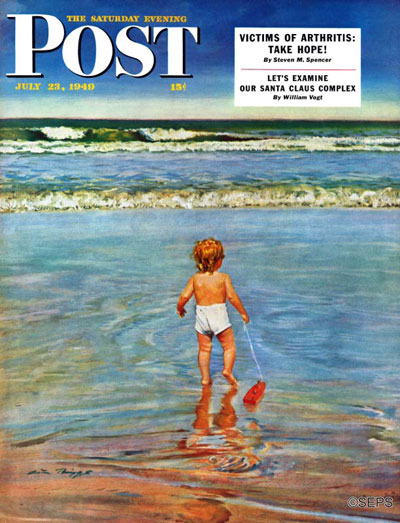
July 23, 1949
With Mom preoccupied, this baby can pick up a few early glamour lessons, though it would appear she hasn’t quite mastered coloring inside the lines.
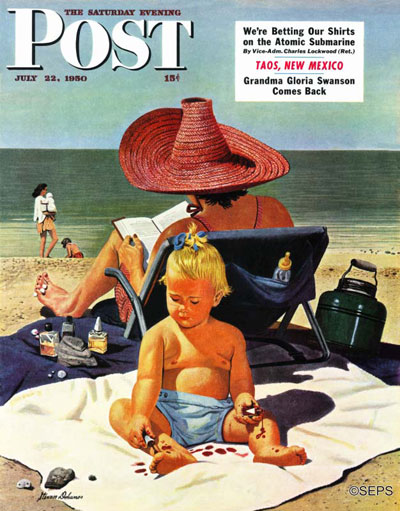
July 22, 1950
So much for fun in the sun. If the obsidian cloudbursts weren’t enough, a few peals of lightning are good reason to send sunbathers and picnickers packing.
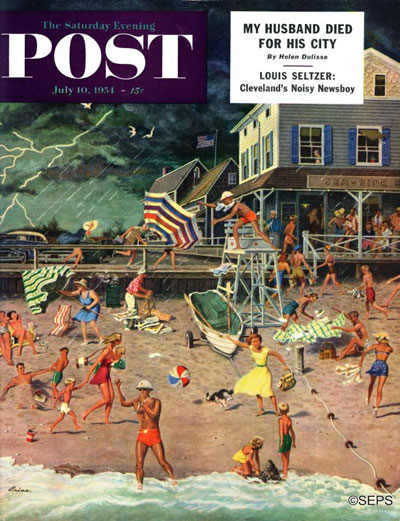
July 10, 1954
Who says you can’t mix work and play? Sipping a soda and rocking a bonnet-clad tot, this babysitter just might perfect the art of multitasking as long as that begrudging chef doesn’t boil the milk.
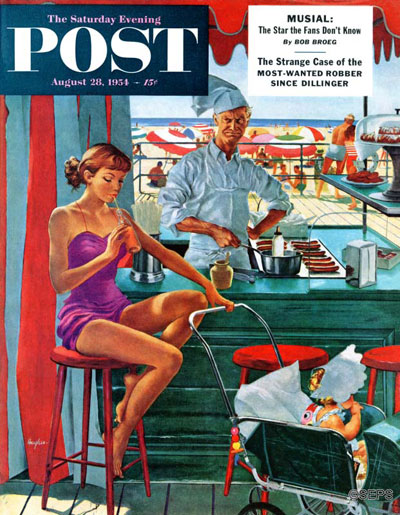
August 28, 1954
There’s plenty of fish in the sea, but the odds of this fellow catching one bigger than a guppy might be doubtful, especially with a snickering chorus of freckled critics present.
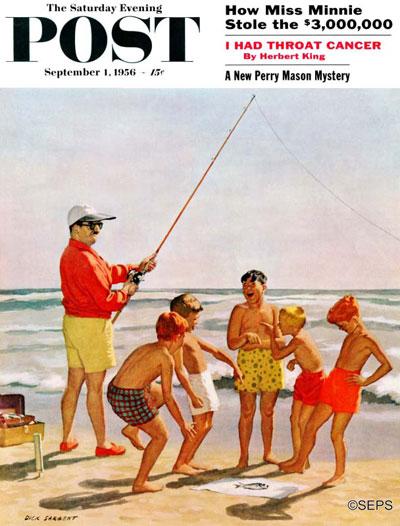
September 1, 1956
Even with enough lotion globbed on to withstand most natural disasters, some are just bound to flake under the harsh afternoon rays. Of course, where some see searing obstacles, others see opportunities to pick up a glorious golden sheen.
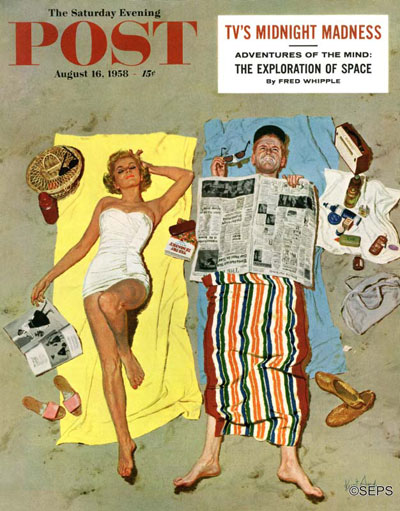
September 16, 1958
Forget frolicking in the surf when there’s romantic comedy of this caliber to be had.
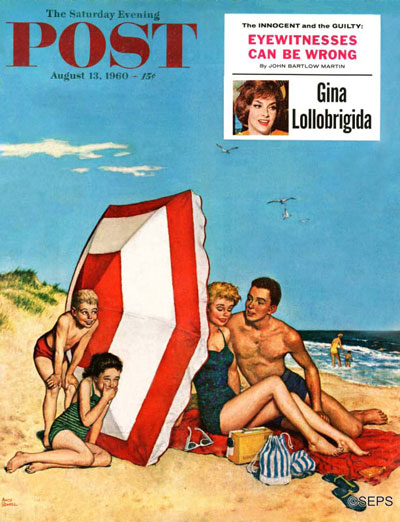
August 13, 1960
Perhaps auditioning for the Polar Bear Club under the disgruntled gaze of that swaddled lifeguard, this brave swimmer can have the entire shore to himself, as long as he doesn’t mind a touch of hypothermia. Like age, temperature is just a number.
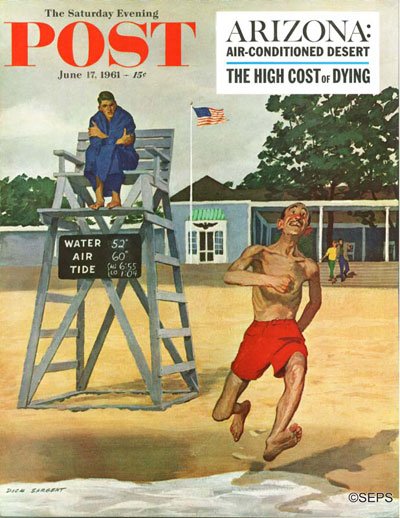
June 17, 1961
Summer Fun
It’s the season of empty classrooms, sleepy afternoons, and mercury rising up the meter. These covers offer a glance at the happy-go-lucky methods of sun-baked escapism for adults and kids alike.
Sliding into Water – Lawrence Toney
Sand between your toes and surf lapping at the shore is fine and good, but the neighborhood waterslide can serve just as well. For some, a pair of trunks and the rush of gravity are more than enough to beat the heat.
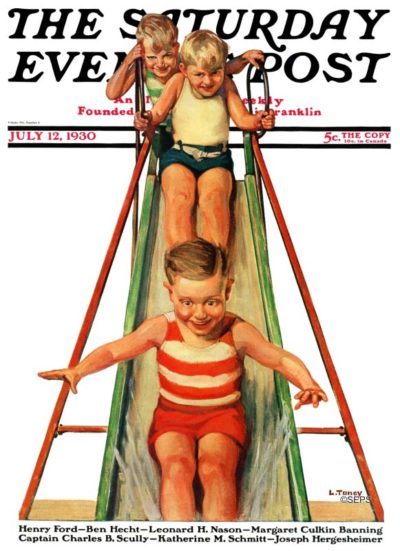
July 12, 1930
Water Fight – Thornton Utz
Providing the water supply holds out, a little mirth and mayhem can turn a suburban lawn into an amphibious battleground. Thorton Utz’s work is a giddy cautionary tale for everyone walking by to hike up their socks.
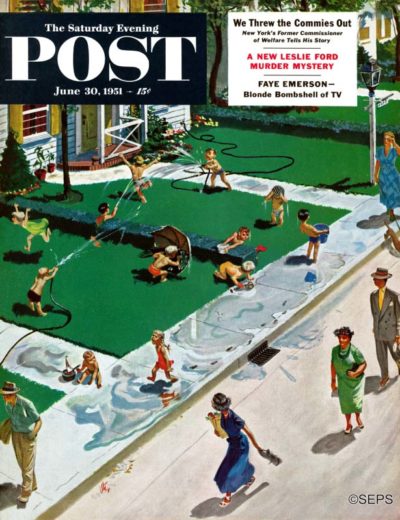
June 30, 1951
Croquet Game – John Falter
The family tournament portrayed in John Falter’s Croquet Game makes for a fitting post-Sunday dinner capper as the sunlight steadily trickles away.
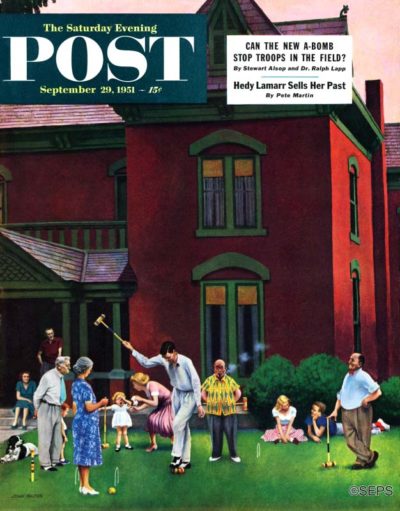
September 29, 1951
No Girls Allowed – Stevan Dohanos
A ramshackle paradise tucked into the trees makes the perfect lazy afternoon retreat for the adolescent crowd still harboring fears of a cootie outbreak. With trumpet, pooch, and crossbones all aloft, they can’t want for much.
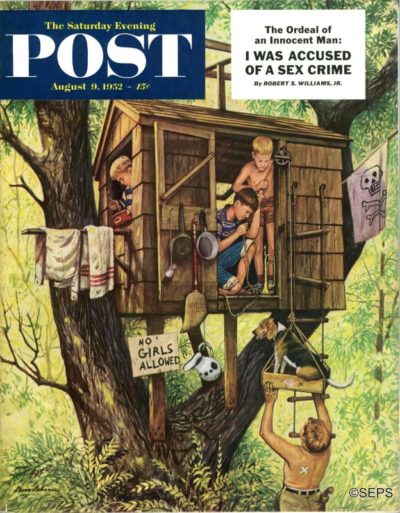
August 9, 1952
Feeding the Elephants – John Clymer
Getting up close and personal with a pair of curious pachyderms may be the thrill of the afternoon, but that motley bouquet of balloons just beyond the elephant habitat is sure to draw some new customers in the immediate future.
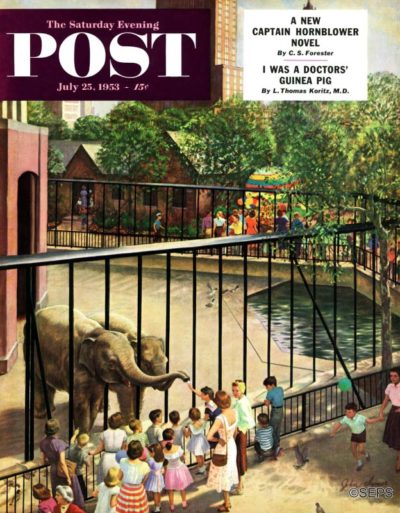
July 25, 1953
Town Green – John Clymer
A tot jamboree, future hall-of-fame hopefuls, and lounging bookworms round out the cast of John Clymer’s sprawling Town Green, where all can bask in the stippled shade around the gazebo.
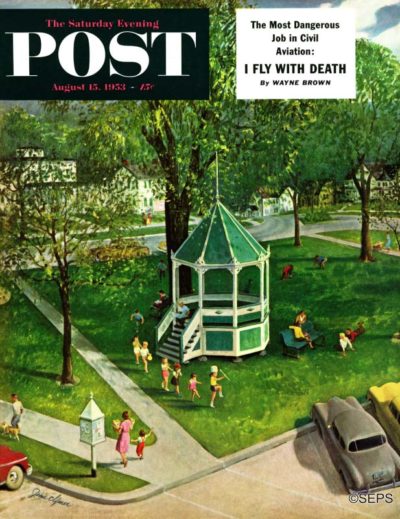
August 15, 1953
Backyard Campers – Amos Sewell
A bump in the night is never welcome when all you have are tent flaps for defense. And a few ghost stories too many can render the most innocuous cicada chirp into a sinister bogey-beast on the prowl.
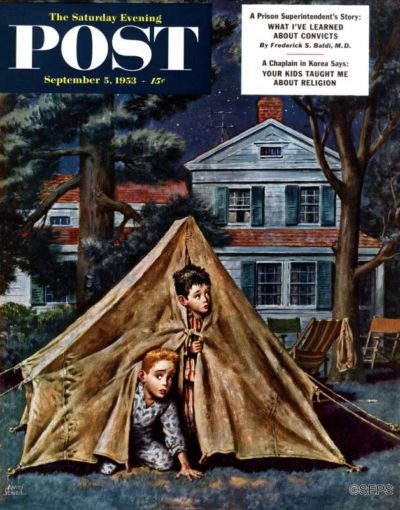
September 5, 1953
Lemonade for the Lawnboy – George Hughes
A shiny quarter would be welcome, but when trimming the lawn in the sticky heat of early summer, payment in icy fresh-squeezed lemonade is just as appreciated.
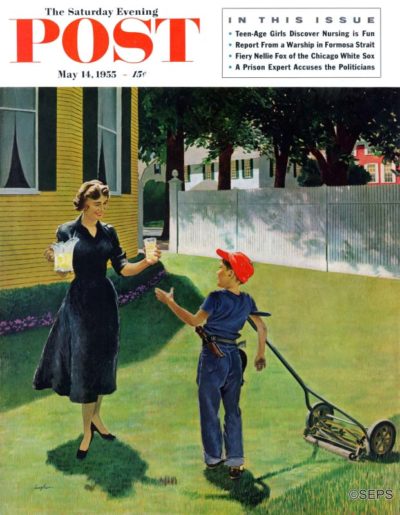
May 14, 1955
Wading Pool – Amos Sewell
Even if one size doesn’t fit all, when the kiddie pool is the only escape from August heat, most are willing to make due. You snooze, you lose.
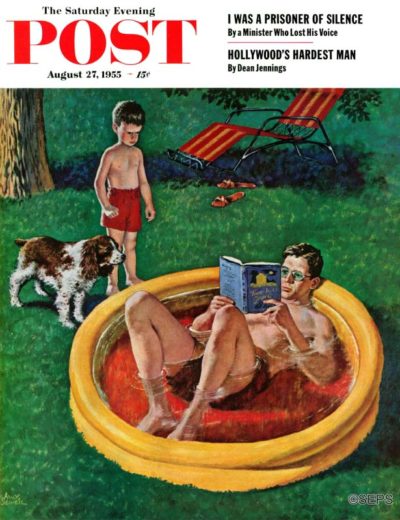
August 27, 1955
Swing-set – Amos Sewell
With shoddy materials and blueprints more complex than the Manhattan Project’s, dad may end up getting better exercise than the kids. Luckily for his patient audience, this dance more than makes up for the lack of functioning swings.
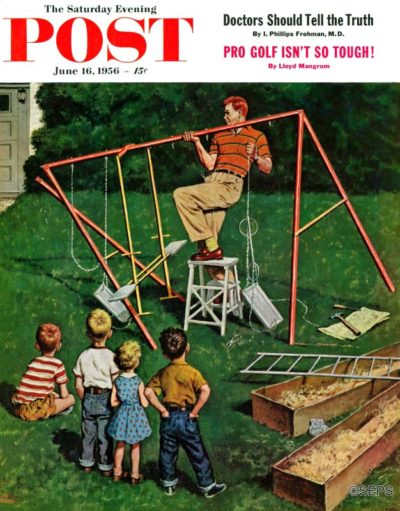
June 16, 1956
Billboard Painters – Stevan Dohanos
In mid-July swelter on the cusp of a scorching third digit, these workingmen are wise to take the advice of their arctic billboard. Unfortunately, no amount of wishful thinking can convince their fictional polar pals to share the snow.
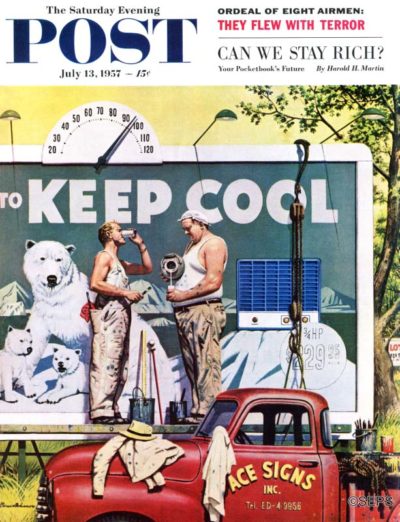
July 13, 1957
Where the Girls Are – Thornton Utz
As shown in Thorton Utz’s Where the Girls Are, the discerning college boy always has one eye open for opportunity, even in excess of the speed limit.
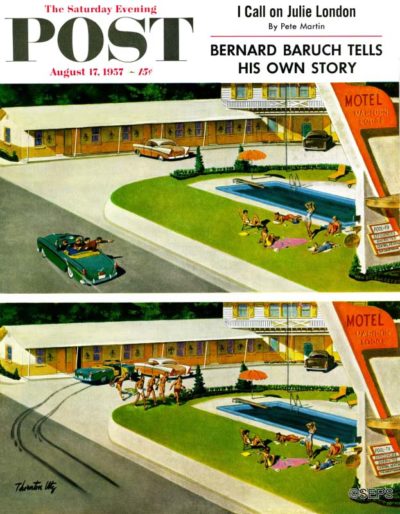
August 17, 1957
The Modern Vacation
Fun for the Whole Family!
The educational road trip leading up to a spectacular vista is not always appreciated by those for whom all that effort was expended. Artist Richard Sargent was also a father and the complex and often hilarious child-parent dynamic was a regular theme.
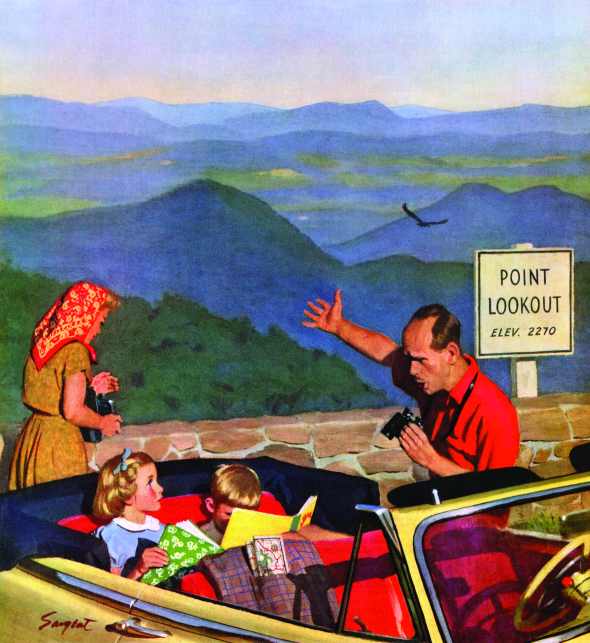
Richard Sargent
The Saturday Evening Post
July 18, 1953
Beached
Retirees in the 1930s may not have known how to dress down for the shore, but they seem to be enjoying the sand just as much as their modern-day equivalents do.
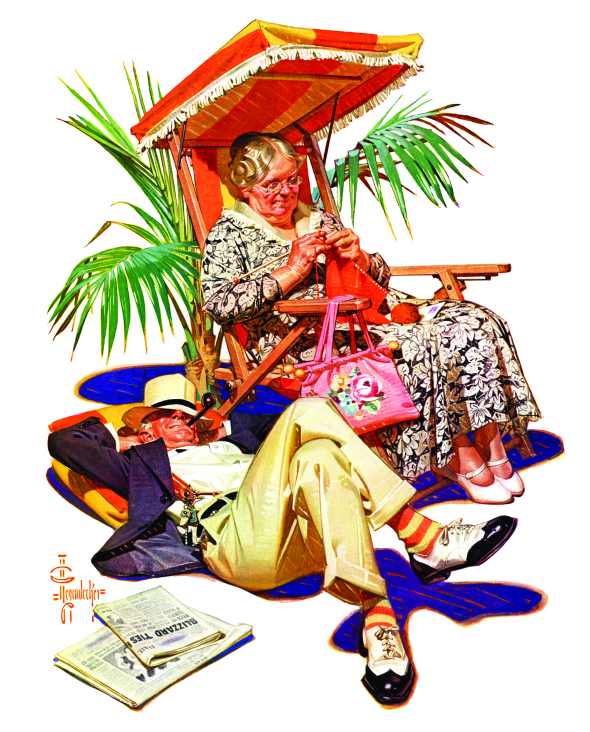
J.C. Leyendecker
The Saturday Evening Post
February 20, 1937
Dedicated vacationers march to the water first thing in the morning, forming an impromptu parade.
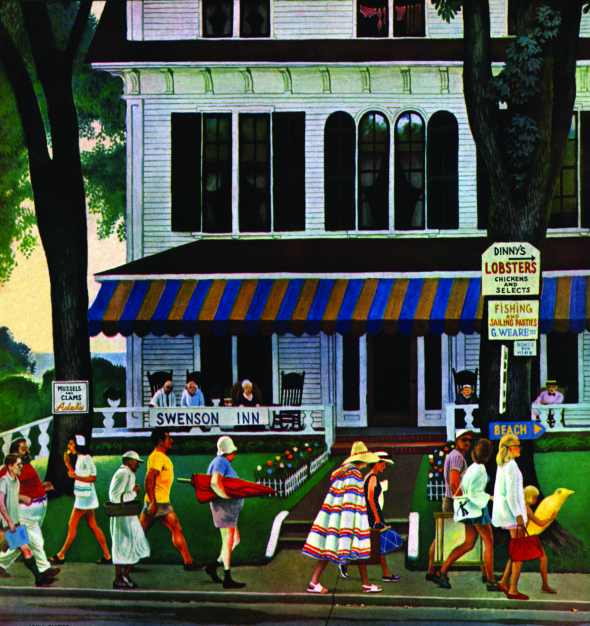
John Falter
The Saturday Evening Post
August 2, 1947
Baggage
Universal Truth No. 1: After a week at the beach, you will accumulate at least twice the baggage that you arrived with.
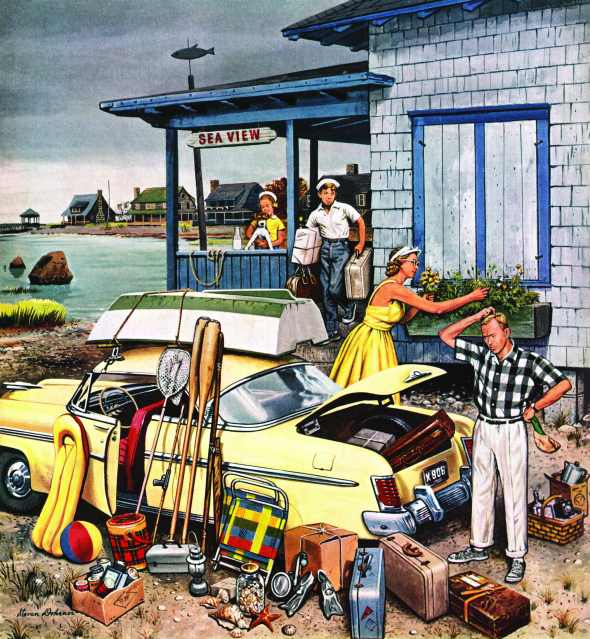
Stevan Dohanos
The Saturday Evening Post
September 8, 1956
Universal Truth No. 2: Vacations are short and much anticipated, which doesn’t leave time for unpacking — at least not in Dad’s view.
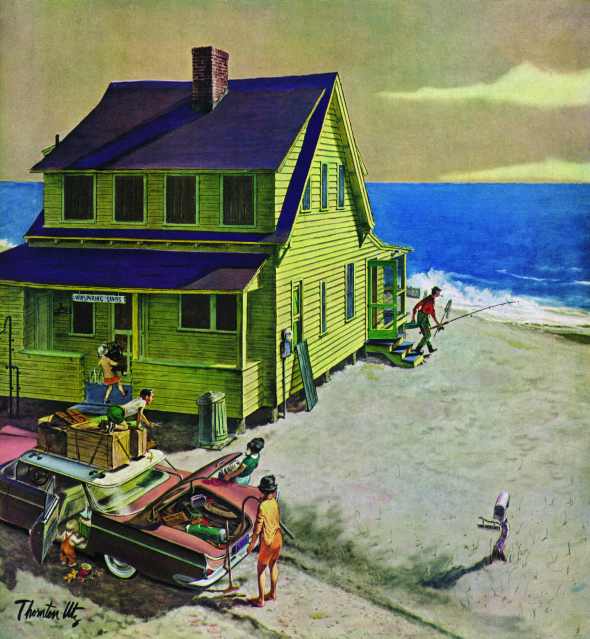
Thornton Utz
The Saturday Evening Post
June 18, 1960
Disappointment
When your job is to help others achieve their dreams as is the case for this travel agent, sometimes you need a quiet moment to dream one up for yourself.
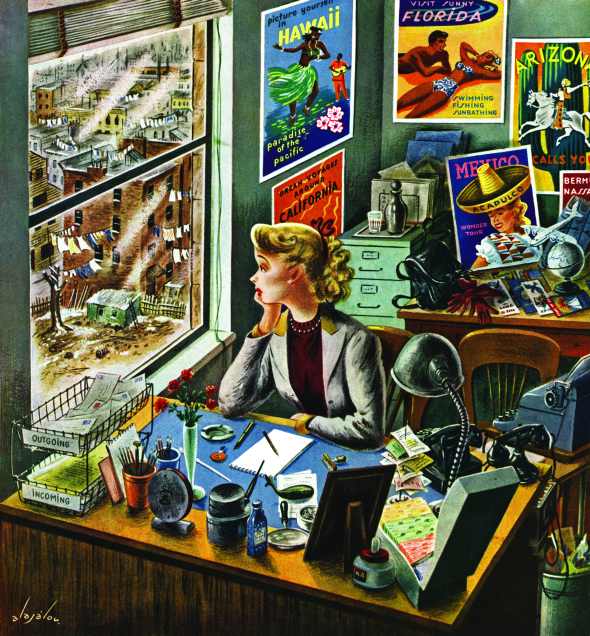
Constantin Alajalov
The Saturday Evening Post
February 12, 1949
You can’t plan the weather for that dream vacation, but this family is determined to get in as much outdoor time as humanly possible.
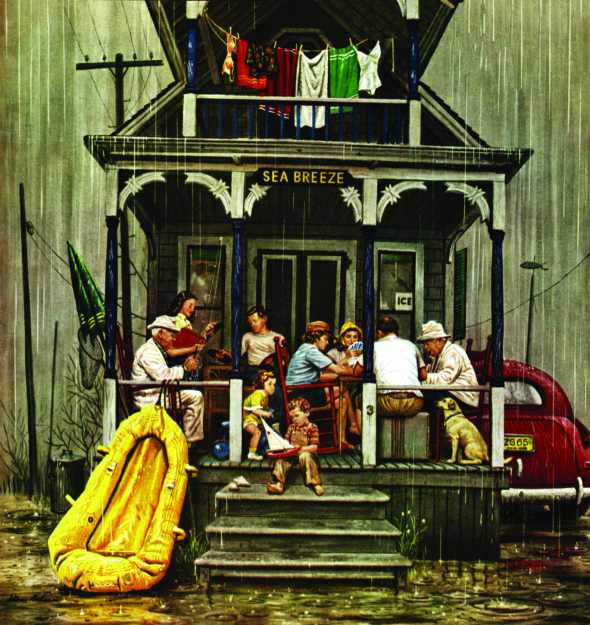
Stevan Dohanos
The Saturday Evening Post
July 31, 1948
Back Again
When you go away for what looks to be about three weeks — judging from the number of newspapers on the lawn, strewn about the front entry by some lout of a paperboy — there’s a lot of cleanup to be done. The weight of this realization is quite evident in the droop of Father’s shoulders.
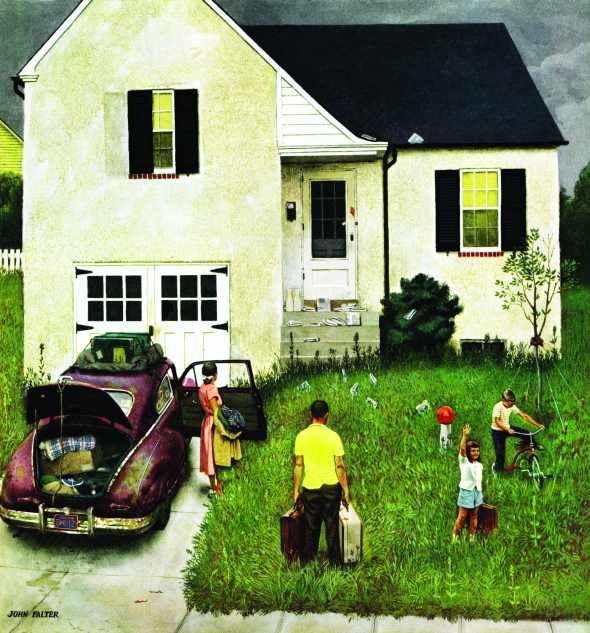
John Falter
The Saturday Evening Post
August 23, 1952
There may be no place like home, but after a long trip, Rockwell’s family requires rest.
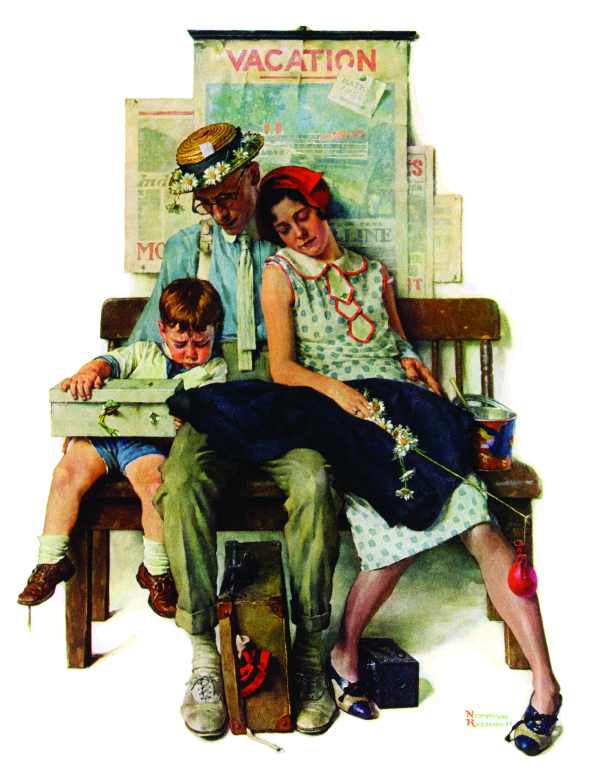
Norman Rockwell
The Saturday Evening Post
September 13, 1930
What a Man’s Gotta Do
Fatherhood
Dad’s role, as depicted in midcentury America, was to be the breadwinner, play the occasional game of catch, and generally set a good example for his boys. And, oh yes, no one else can give the son “the talk,” unpleasant though it clearly is for both of them.
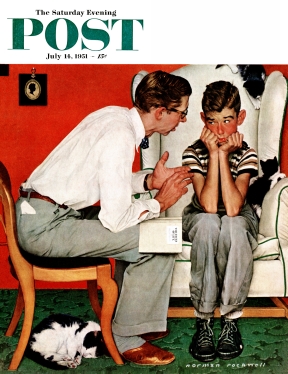
Norman Rockwell
July 14, 1951
Get this framed at Art.com
Nightwatch
It wasn’t common to see fathers caring for babies in public; but in the privacy of the home, dads had to step up, if not always happily. In 2:00 Feeding (below), our subject appears tiny and trapped, the design emphasizing his isolation from the world outside.
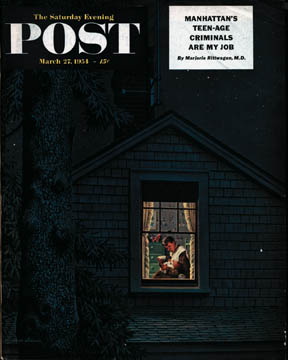
Stevan Dohanos
March 27, 1954
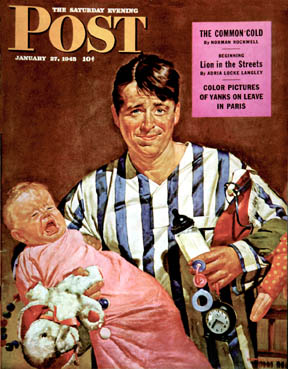
Howard Scott
January 27, 1945
Unhappy Campers
Precise composition supports the narrative in these two amusing paintings of dads oppressed by duty. In Dad, the Fish are Biting (below), notice how contrasting wishes are suggested with shadow, one side dark, the other light.
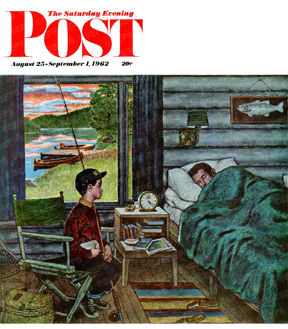
Amos Sewell
August 25, 1962
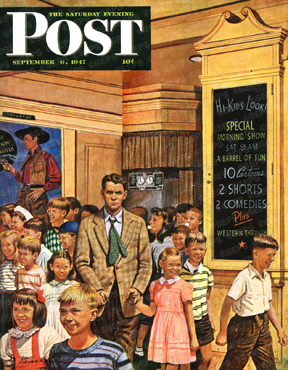
Stevan Dohanos
September 6, 1947
More fathers on the covers of The Saturday Evening Post (click on the covers to see larger image):
Football, American Style
Kick off this football season with this classic cover collection that spans six decades capturing the spirit of American football, from childhood games to college gridiron to the professional field.
Football, American Style — Click covers to see larger image.
J.C. Leyendecker
November 15, 1913
J.C. Leyendecker
November 21, 1914
Norman Rockwell
November 21, 1925
Harrison McCreary
October 16, 1926
Frederic Stanley
November 13, 1926
J.F. Kernan
October 15, 1932
J.C. Leyendecker
November 4, 1933
E.M. Jackson
October 23, 1937
Frances Tipton Hunter
November 27, 1937
Russell Sambrook
October 26, 1940
Lonie Bee
November 14, 1942
Constantin Alajalov
October 23, 1948
Stevan Dohanos
November 25, 1950
Constantin Alajálov
December 5, 1959
Paul Calle
September 21, 1968
See more cover art from some of the artists featured here:
Constantin Alajálov
Stevan Dohanos
John Falter
Frances Tipton Hunter
J.F. Kernan
J.C. Leyendecker
Norman Rockwell
Stevan Dohanos
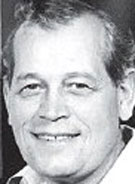
Stevan Dohanos, born May 18, 1907 in Lorain, Ohio, grew up as a great admirer of Norman Rockwell, going so far as to copy his Saturday Evening Post cover illustrations in crayon that he sold to friends, relatives, and co-workers. Little did Stevan know, he would develop a close personal friendship with Rockwell as his own art graced the Post’s cover 123 times over the course of his lifetime.
Dohanos was the third of nine children born to Hungarian immigrants Elizabeth and Andras Dohanos. His upbringing in a midwestern steel town would later influence the cultivation of his artistic style showing the normalcy and realism of American life. While inspired by Rockwell’s talent, Dohanos became an “American Realist” who depicted everyday life as it was. He was most heavily influenced by the work of Edward Hopper, and chose not to idealize American life the way Rockwell did.
Dohanos realized his love of art fairly early in life, selling calendars and illustration copies for $1.00 to $3.00 apiece while he worked in a grocery store and later at an office job. He began his formal education by taking correspondence classes through the International Correspondence School. Soon after, the artist took night classes at the Cleveland School of Art where he received a scholarship to complete his formal art studies.
During and after art school, the young Dohanos worked in a Cleveland advertising firm, then travelled around the country painting wall murals before heading to New York City to work as a commercial artist. He eventually moved to the artist colony of Westport, Connecticut where he found inspiration in the everyday lives of his neighbors.
While working in the city, Dohanos picked up advertising work from clients such as Four Roses Whiskey, Maxwell House Coffee, Pan Am Airlines, Cannon Towels, Olin Industries, and John Hancock Insurance. His work was featured in Esquire, Medical Times, McCall’s, and Colliers prior to his first successful submission to The Saturday Evening Post. In September of 1938, he married his longtime sweetheart, Margit Kovacs, and had two children, Peter and Paul.
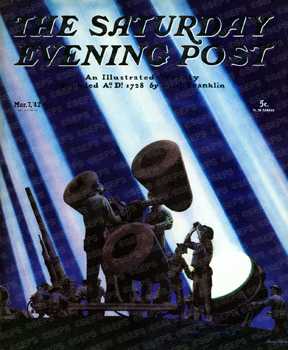
Stevan Dohanos
March 7, 1942
His first Post cover, the March 7, 1942 issue, was a well-received wartime image of air raid searchlights from an artillery battery. Throughout the 1940s and 1950s, the artist’s workload for The Post increased, garnering a contract for roughly a dozen covers a year.
During World War II, Dohanos aided the war effort by painting recruitment posters and wall murals for federal buildings. He also designed stamps for the federal government, starting during the Roosevelt administration, and staying in the profession the rest of his life.
As magazine covers turned toward photography and away from illustration, Dohanos quickly changed careers. He did film art for such classics as White Christmas and was the chairman of the National Stamp Advisory Committee where he oversaw the art design for over 300 stamps. He held the position throughout the administrations of 7 presidents and 9 Postmaster Generals. His depictions include presidential portraits, the now collectible NATO commemorative stamps from 1959, and the 1967 John F. Kennedy commemorative stamp.
Stevan Dohanos found beauty in everyday life, choosing to focus on “the location and trappings of the American dream, not those who populated it.” Elevated to lofty status as a famous Saturday Evening Post illustrator, Dohanos’s works now garner the walls, halls, and galleries of The Cleveland Museum, The New Britain Museum of American Art, The Pennsylvania Academy of the Fine Arts, Dartmouth College, The Whitney Museum of American Art, and various federal post offices across the United States. He died July 4th, 1994 at the age of 87.
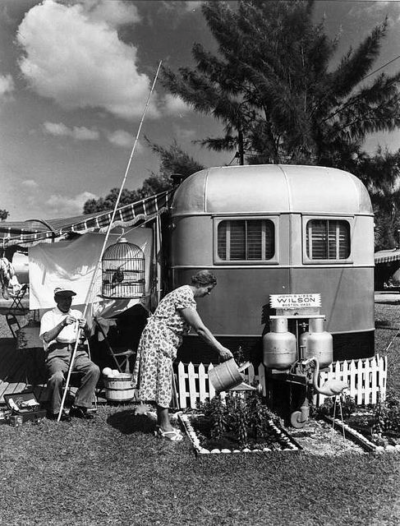
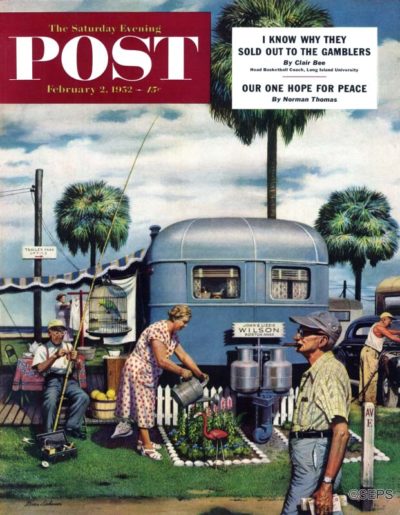
Stevan Dohanos hewed closely to the photo that he used to create this homey Florida scene for our February 2, 1952, cover.
Covers by Stevan Dohanos
Inflating Beach Toy
Stevan Dohanos
August 20, 1949
Trailer Park Garden
Stevan Dohanos
February 2, 1952
Toddler Empties Purses
Stevan Dohanos
November 22, 1952
Beyond the Canvas: Fireworks, Fanfare, and the 4th of July
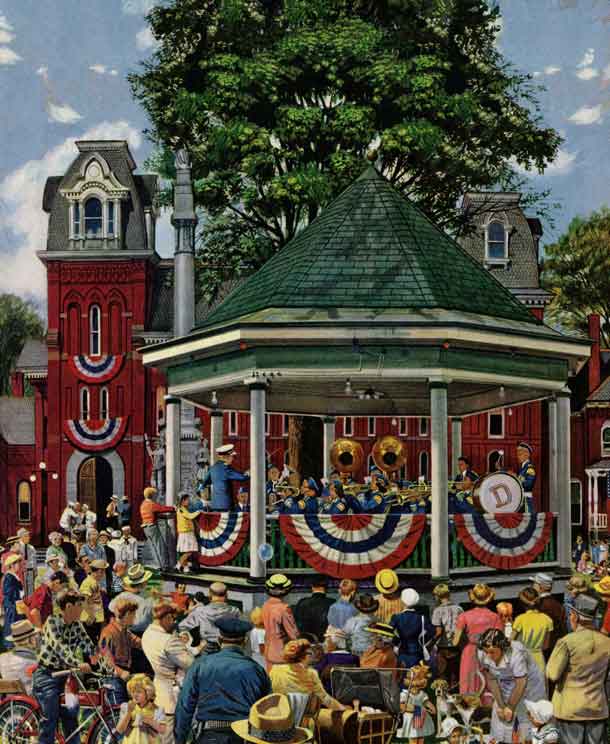
Stevan Dohanos
July 7, 1951 © SEPS
The Saturday Evening Post has celebrated many American Independence Days with beautiful covers that set the country’s mood for the red–white–and–blue doused holiday.
On past covers, our artists chose a variety of ways to show how Americans have gathered for the 4th of July.
The day brings out bands, orchestras, and symphonies to dust off the sheet music and play familiar American tunes.
Stevan Dohanos‘ Patriotic Band Concert from July 7, 1951, shows a community square filled for the day’s brass fanfare.
The lofted gazebo allows attendees a good listening spot from all around the town center. Cities and small towns alike still have parades, ceremonies, concerts, and picnics they offer free of charge.
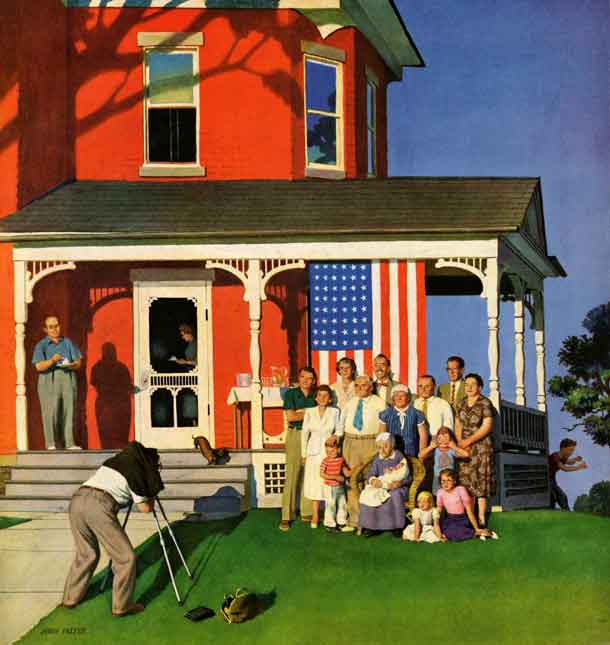
John Falter
July 5, 1952 © SEPS
Our July 5, 1952 cover, Family Portrait on the Fourth by John Falter makes a picture of the fourth of July day itself.
He incorporates the house and unremarkable-yet-presumably-American landscape to create a portrait of celebration in the rural, maybe even more ‘traditional’ parts of the country.
The blue sky, red house, and white porch all enhance the colors of the flag in front of which this family gathers to have their picture taken.
And last but not least, what would Independence Day be without the spectacle of independence night? Ben Prins’ Fireworks from July 4, 1953 marks the holiday’s end with celebratory bombs bursting in air, as we pay homage to those who have fought and died for our country.
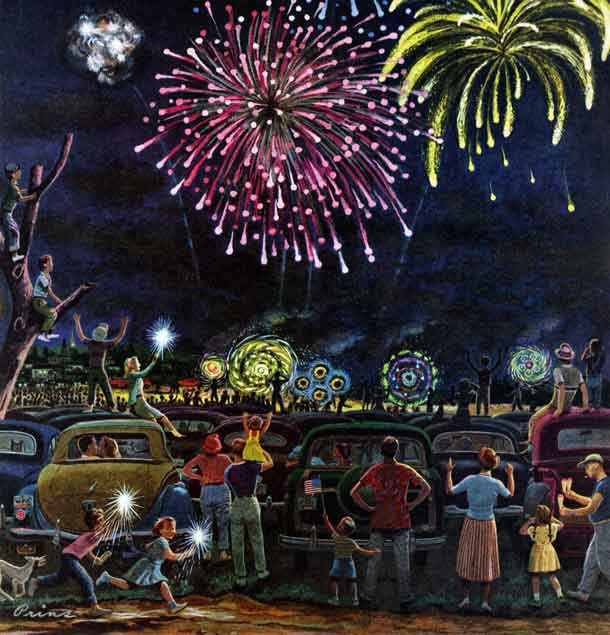
July 4, 1953. © SEPS 2014
If you look closely, you’ll notice that the color scheme of the sparks form a choreographed red, white, and blue flag.
The holiday can be a sticky, humid afternoon of grill smoke and supply errands. But at the end of the gatherings, the family portraits, and the concerts, we settle in for the evening spectacle.
Many families will prepare s’mores over a fire, and await booming fireworks that signal the end of yet another American Independence Day.
Beyond The Canvas: Grandstand Grand Slam
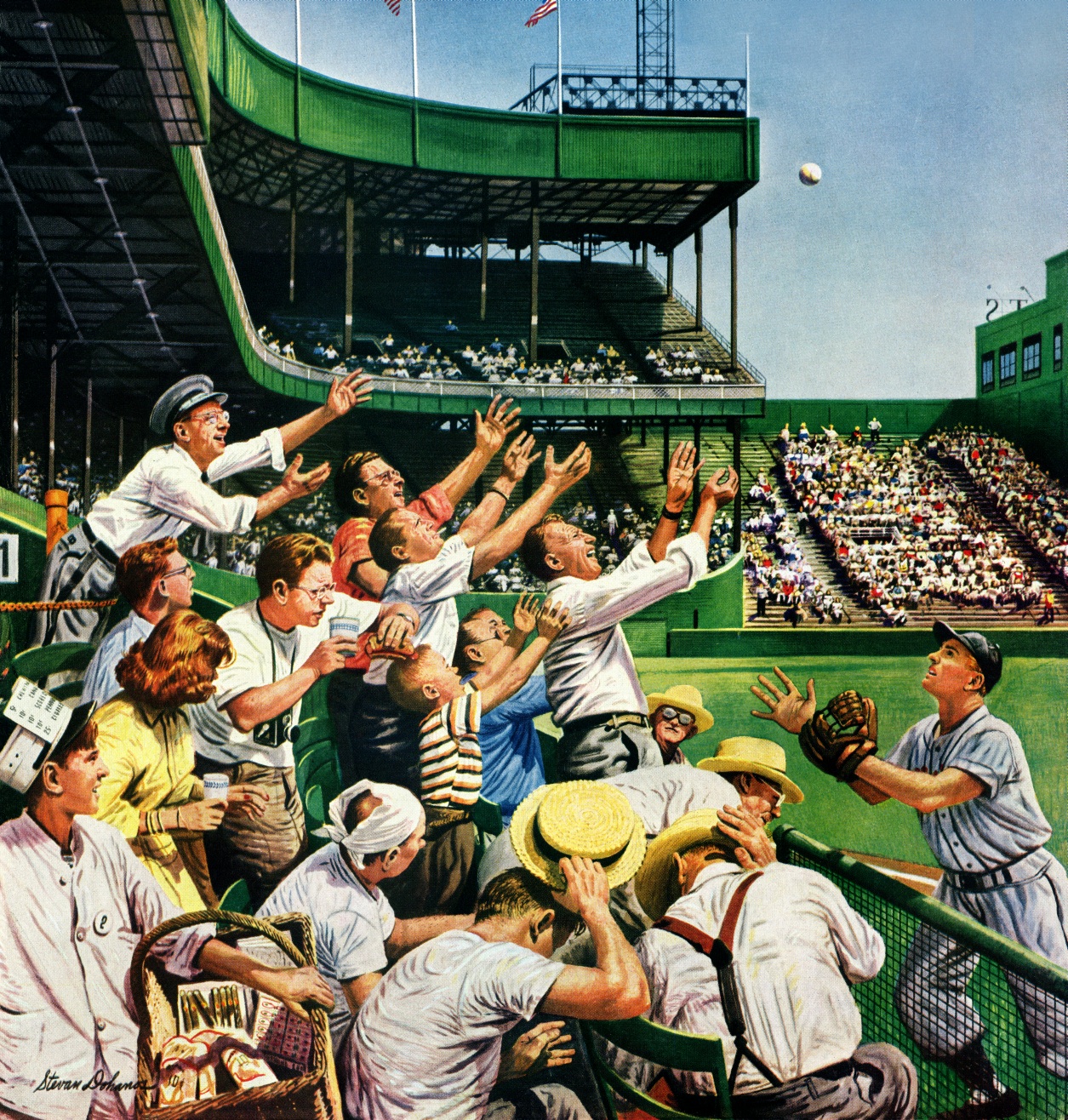
April 22,1950. © SEPS 2014
Click here to license this and other artwork by Stevan Dohanos.
Click here to purchase this and other artwork by Stevan Dohanos from Art.com.
April welcomes the fresh green bloom of spring, as well as Opening Weekend for America’s favorite pastime: baseball.
In his April 22, 1950 cover for The Saturday Evening Post , illustrator Stevan Dohanos depicts a wide variety of reactions to an incoming fly ball on a sunny day at the ballpark.
The green upper decks curve around the back end of the stadium and enlarge the grandeur of the atmosphere as they approach the outfielder’s apparently useless attempt to catch a ball among the throngs of an excited crowd.
This game is not a casual affair taking place over a relaxing weekend afternoon. This outing plays host to a devoted baseball following. The scene takes place somewhere between late morning and afternoon. The adults in the stands are playing hooky, and should they catch that prize ball, they would have no one and nowhere to brag to for fear of being discovered out of the office. If you look carefully into the crowd, most of the men are still wearing their work attire. They have rolled up sleeves, but they still wear slacks, ties, button-down shirts, suspenders, and even a bus driver’s hat on the man in the back row.
The illustration shows that love of the game transcends generations. Boys and men all reach to the sky, hopeful for momentary fame, hoping to be “that guy” lucky enough to snatch a professional, maybe even game-ending ball. For the men, there are resurgent childhood dreams of one day playing professionally. The boys in the stands are instilled with those hopes and dreams for the first time.
Structurally, Dohanos composes a triangle across the cover by using the reaching crowd and outfielder as linear markers to draw the viewer’s eye to the falling trajectory of the incoming baseball. The immense stadium and rows of stands are simply background to the scene unfolding at the painting’s foreground.
The color palette blends the semi-yellowed field with the straw hats and yellow dress of the baseball-avoiding bystanders. The bright yellow colors disperse the white-collar chaotic mess in the stands. Some individuals sit back without a care while others hide or turn away. A select few in the section dive for the ball.
Like the viewer, the rest of the stadium watches this freeze-frame scene. The narrative indicates that a fan’s catch would ensure a home run against the outfielder jumping for the fences. We are brought into the scene’s tension, the game, and the stadium’s excited, cheerful atmosphere.
64 years later, America still eagerly awaits the baseball season and its longstanding tradition of spring’s Opening Day. The fields are watered and mowed, the sun is shining, and there’s always a chance it could be any one of us in the stands, ready to catch that home run ball.
 To learn more about Stevan Dohanos and to see other inside illustrations and covers from this artist, click here!.
To learn more about Stevan Dohanos and to see other inside illustrations and covers from this artist, click here!.Spring Covers: A Perennial Favorite
The spring equinox occurred weeks ago, March 20 to be exact, which means this winter’s tale has (finally!) come to a welcome end.
Here at The Saturday Evening Post, we have historically welcomed each spring with delightful covers from some of our greatest artists and illustrators, each cover offering a different take on varied spring themes. The following three covers show the range of springtime weather, and the ways we take advantage (or don’t) of the change in season.
The most prevalent activity of spring is the tending of of gardens. In Thornton Utz’s, “Spring Yardwork” from May 18, 1957, the viewer sees an entire neighborhood planting, watering, mowing, mulching, raking, and so on and so forth down the straight line of synonymous 1950s homes.
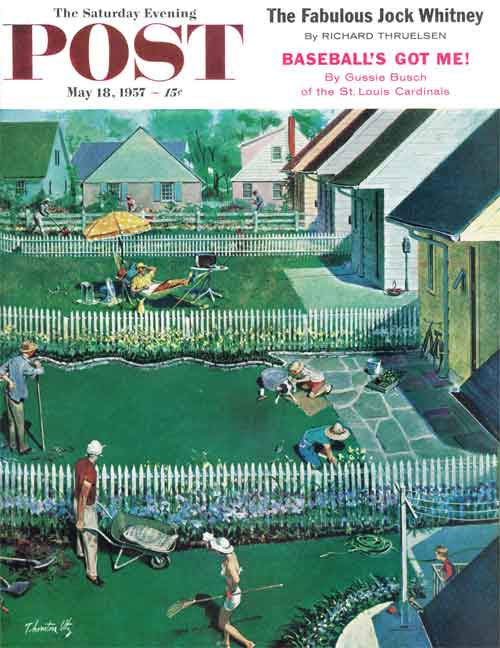
At the far end of the street, we view a man sunbathing in a yard completely lacking any cultivation. There are no perennials, no sprouting annual bulbs planted the previous fall, and he is not planting for the summer harvest. If anything, the old parable of the grasshopper and the ant comes to mind.
The lazy grasshopper homeowner at the far end looks out jealously from his lawn chair and barren yard to see the fruits of his ant neighbors’ labors. It’s not too late for him to make hay while the sun shines, but he looks awfully comfy drink in hand.
From sunshine to April showers, “Mailman” by Stevan Dohanos, which appeared on the May 13, 1944 issue, shows a devoted neighborhood staple, the rain-or-shine employees of the United Sates Postal Service completing his daily duties in a solemn, light afternoon shower. The mailman is an American ideal of civil service, the difficulty of his responsibilities unknown to those who conveniently find their mail waiting, as if by magic, in their mailboxes.
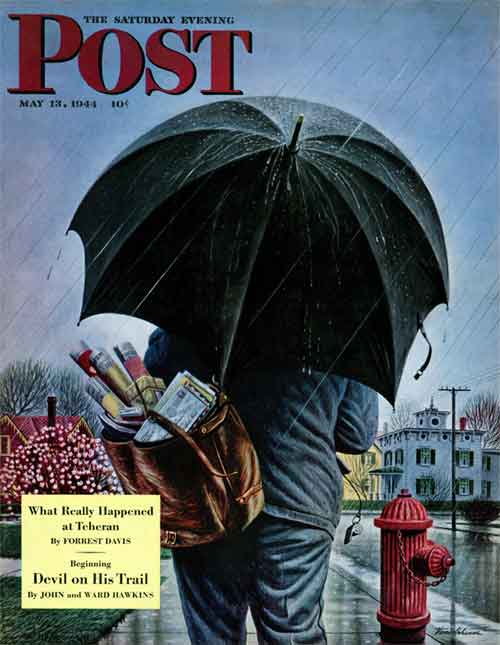
In contrast, “Spring Cleaning” by John Falter, from the March 26, 1949 cover, shows people who, unlike Dohanos’ mailman, have the luxury of finishing their chores on a beautiful, sunny day. Most would rather have fun on a sun-kissed afternoon, but completing a task in good weather is certainly preferable to the rain.
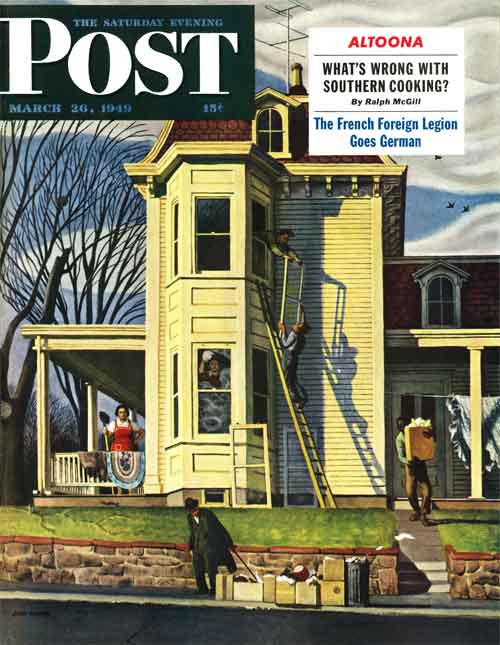
This season has much to offer, so take advantage! It’s time to head outside, to enjoy warmer weather, to plant our gardens, and to take charge of our spring-cleaning procrastinations (or eh, maybe next year). This season of early awakenings only comes once a year, so make sure to take a moment and appreciate this singular spring season.
Classic Covers: Yard Work
From mowing and tree planting to a neighborhood nonconformist, 1950s-style, these timeless covers are just in time to inspire you to tackle that yard.
Woman in Wheelbarrow
Ellen Pyle
June 20, 1931
Ellen Pyle (1876-1936) was known for her beautiful use of color. In 1927, she received a note from fellow cover artist Norman Rockwell about how much he liked her Post covers. “They are dandy. So full of color and so broadly painted. Believe me I envy you the latter quality particularly,” he wrote, according to Delaware Art Museum’s Illustrating Her World: Ellen B. T. Pyle.
As in many of her 40 covers for the Post, the model is one of Pyle’s children. In this case, teenage daughter Caroline is taking a wheelbarrow break from gardening duties.
Baseball Player Mowing the Lawn
Stevan Dohanos
July 20, 1946
“When summer rolled around,” wrote Post editors of this 1946 cover, “and the grass in Westport, Connecticut, began to grow as fast as a small boy’s hair, Stevan Dohanos recalled one of the duties of his youth and how mowing the lawn can ball up a man’s more important engagements.”
The frame house, however, was not in Connecticut, but back in artist Dohanos’ (1907-1994) hometown of Lorain, Ohio. Editors noted that he sketched it a couple years before it appeared on the cover. “Obviously it was a good stage, a good setting, but he never had decided just what story to tell against this background. Now he uses it to tell of a common summertime crisis—when the star pitcher has to work,” Post editors wrote.
Put the Tree There?
George Hughes
April 9, 1955
Illustrator George Hughes (1907-1990) was an avid outdoorsman, but we’re not sure how he felt about planting trees. He would probably feel the same as the poor guy from the local nursery on this 1955 cover, if he had to deal with an indecisive homeowner.
Hughes painted 115 Post covers, and was especially productive in the 1950s. Typical output for the more popular illustrators was around 40 to 50 covers during a decade. Hughes’ friend Norman Rockwell, for example, did 44 during this period. Hughes did 80 in this timeframe; mostly fun, slice-of-life scenes from midcentury suburban life.
View more in the George Hughes gallery.
Artist Thornton Utz (1914-2000) enjoyed gently bucking the trend and depicting the neighborhood nonconformist. Mr. Leisure in this 1957 cover uses his backyard purely for relaxation, not caring how high the grass gets.
Meanwhile, in nearby yards, neighbors are flummoxed by Mr. Leisure’s indifference—at least those who can spare a second from their suburban chores.
Spring Yard Work
Thornton Utz
May 18, 1957
Even the little girl in the middle yard wastes no time as she tends to her dog’s bath. Post editors mused that the cover might start a debate “about whether people should nourish their backyards or let their backyards nourish them.” We’ll let the reader decide.
Classic Art: George Washington
George Washington was a favorite subject of artists like J.C Leyendecker, N.C. Wyeth, and Stevan Dohanos. In all, the first president of the United States has appeared on the cover of The Saturday Evening Post 10 times.
Washington Crossing the Delaware
Washington Crossing the Delaware
Stevan Dohanos
February 24, 1951
It is daunting to consider the work realist painter Stevan Dohanos put into this painting. Reproducing images of over a dozen students (and their teacher) with meticulous detail should have been artistic challenge enough, but duplicating Emanuel Leutze’s famous 1850 painting is mind-boggling.
Much has been criticized about Leutze’s Washington Crossing the Delaware: “The crossing was at night (not daytime)”; “That particular version of the flag came later”; and “Washington was only in his 40s and not the elderly man we see here”; to name a few. While the historical inconsistencies are worth noting, the huge 21-by-12-foot painting of that 1776 Christmas night is still a magnificent accomplishment and a tribute to a critical turning point in American history. The painting today is part of the collection of the Metropolitan Museum of Art in New York City.
From 1942 to 1958 Dohanos painted 123 Post covers, which can be viewed in our online gallery or at art.com.
First Farmer of the Land
First Farmer of the Land
N.C. Wyeth
Country Gentleman
February 1946
N.C. Wyeth was described in a 2011 Post article by Edgar Allen Beem as “a larger-than-life figure, a swashbuckler of a man whose dramatic illustrations fired the imaginations of generations of readers.” This portrait of Washington was Wyeth’s last work. Country Gentleman editors noted in 1946, “He was working on it at the time of his tragic death at a grade [train] crossing last fall. It is, therefore, an unfinished work. We preferred to have you see it this way than let some lesser artist finish it.”
Wyeth, who had used George Washington as a subject several times, was a natural choice to illustrate the article about the farming habits of the former president. “Mr. Wyeth did exhaustive research on Washington’s farming operations so that this picture might be accurate in every detail,” editors noted. Those details clearly include the depiction of slave labor, a factor not addressed in the article, which concentrates on the minutiae of crops and agriculture. According to the article, Washington was so thorough in his farming procedures that he was determined to find out how many seeds of various cereals were in a pound in order to calculate how many pounds to sew per acre. He carefully counted 8,925 barley seeds per pound; 71,000 seeds of red clover; and 298,000 of timothy (this was before the days of grain estimates.)
George Washington and W.W.I Soldiers
George Washington and W.W.I Soldiers
J.C. Leyendecker
June 30,1917
Five of J.C. Leyendecker’s 322 Post covers were portraits of George Washington. His July 1927 cover (George Washington on Horseback) shows a magnificent Washington on horseback in full command of the Revolutionary forces.
This 1917 cover shows the general astride his horse for a latter-day conflict. The United States was involved in World War I and for the Fourth of July holiday, Leyendecker evoked the spirit of the Revolutionary War hero to guide modern-day soldiers through the latest conflict. It was a stirring patriotic scene at yet another critical time in U.S. history.
Classic Covers: The American Teenager
We’ve chosen Post covers between 1909 and 1960 showing the American teenager as depicted by Norman Rockwell, Stevan Dohanos, John Falter, and other great illustrators.
Woman with Basketball
Woman with Basketball
Carol Aus
November 20, 1909
Very little is known today about Norwegian-born illustrator Carol Aus (1878-1934) except that she was known for portrait painting. That talent shines through in this 1909 basketball player.
The Post published seven of Aus’ portraits, all of which appeared on the cover.
Schoolgirl Primping
Schoolgirl Primping
Paul Stahr
September 10, 1921
This pretty cover girl, whose only concern is looking good in a new hat, was created the same year Albert Einstein was lecturing about his new theory of relativity in Stahr’s home state, New York. As a longtime resident of Long Island, Stahr (1883-1953) was close to the East Coast’s publishing companies, and he took full advantage of it. He illustrated for Life and Colliers and was versatile enough to become known as a pulp magazine artist.
The pulps were inexpensive fiction magazines popular from the 1890s through the 1950s (they were printed on cheap paper from wood pulp, hence the name). From 1924 to 1934, Stahr created a number of covers for Argosy magazine, a pulp that boasted authors such as Upton Sinclair and Zane Grey.
Movie Star
Movie Star
Norman Rockwell
February 19, 1938
The Saturday Evening Post had reached its 3-million-circulation milestone just before this cover was published. Rockwell liked to have fun with the familiar logo, and in this case, he obscured part of it with dormitory regulations. The rules state that male companions are not allowed in the dorm at any time, but with a stash of movie-star photos, these teenagers have found a loophole. The idol in hand is actor Robert Taylor, who made millions of female hearts beat faster in his starring role opposite Greta Garbo in Camille. Movie magazines were just then becoming a national pastime—at least among teenage girls, who were trading and swooning over glossy photos of the current heartthrobs.
Rockwell created several covers that included pictures within a picture. Another example of this is The Great Debate, where the newspapers in the illustration clearly show 1948 presidential candidates Truman and Dewey.
March Band at Football Game
March Band at Football Game
Stevan Dohanos
October 19, 1946
Playing an energetic march while keeping a close eye on the game requires dexterity only a teenager can manage, but Stevan Dohanos made sure the rest of us could watch the game in the tuba’s reflection.
Dohanos began this 1946 painting by filling his Westport, Connecticut, home with equipment borrowed from a local high school band. “The tough job,” he said, “was keeping my guests away from the instruments.” Post editors reported “almost everyone who dropped in while Dohanos was at work turned out to be a former musician, the kind who hasn’t laid lip to a trombone for 10 years, but is sure he hasn’t lost the old knack or wants to see if he can still play the second-coronet part from ‘Under the Double Eagle.’”
Fortunately for Post readers, Dohanos did get the job done, and he learned a lesson about his visitors in the process: “I never knew my friends had so much musical talent, or lacked so much.”
Father’s Homework
Father’s Homework
John Falter
May 7, 1960
Of this 1960 cover Post editors asked the question, “If one furrow-browed father spends x hours failing to solve the quadratic equations of one boy, how long would it take two furrow-browed fathers to fail to solve the quadratic equation of two boys?”
Though artist John Falter (1910-1982), a self-proclaimed “dunce in algebra,” may have struggled to find a solution for x, he never struggled to find work as an artist.
He was described by the Post as a workhorse sketching six days a week from 3:00 a.m. to 5:30 p.m. When he entered the Navy during World War II, he found a way to continue his career: he designed more than 300 posters and other recruitment materials for the military. The same year he enlisted, he created his first of 125 covers for the Post.That prodigious output continued throughout his life; it is estimated that he completed more than 5,000 paintings.
Classic Art: Motorcycle Madness
“Soldier on Motorbike” by Lawrence Toney

“Soldier on Motorbike”
by Lawrence Toney
from October 20, 1917
Yes, motorcycles were used in World War I, as this 1917 Post cover indicates. The U.S. military used mainly Harley-Davidson or Indian bikes, and not surprisingly, the British used Triumph, while Germany used BMW motorbikes.
“The Army used an estimated 20,000 motorcycles during the war,” wrote Lisa Gregory in a 2003 issue of Soldiers Magazine. “In fact, the first American to enter Germany after the ceasefire was reported to be motorcycle dispatch rider Cpl. Roy Holz.”
In the first world war era you’d see motorcycles, cars, trucks, and airplanes juxtaposed with cavalry!
“Indian Bike Ad” – September 7, 1918
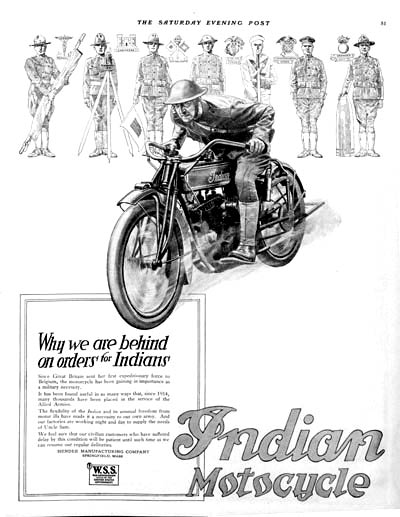
“Indian Bike Ad”
from September 7, 1918
This 1918 Indian ad confirms that thousands of bikes were placed in the service of the Allied armies.
Indian states: “our factories are working night and day to supply the needs of Uncle Sam. … We feel sure that our civilian customers who have suffered delay by this condition will be patient until such time as we can resume our regular deliveries.”
“Indian Police Motorcycles” – February 15, 1913
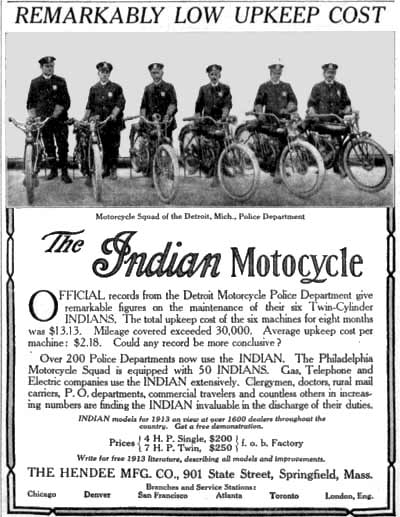
“Indian Police Motorcycles”
from February 15, 1913
Very early in motorbike history, police departments learned the advantage of their maneuverability and convenience. And supplying police and military became a competitive business early in the 20th century.
Although Harley-Davidson delivered a bike to the Detroit Police Department in 1908, this ad from a February 1913 issue of the Post shows the Detroit police with squad of Indian bikes.
Click here for a virtual museum on the history of motor law enforcement.
“Indian Motorcycle With Side Car” – May 9, 1914
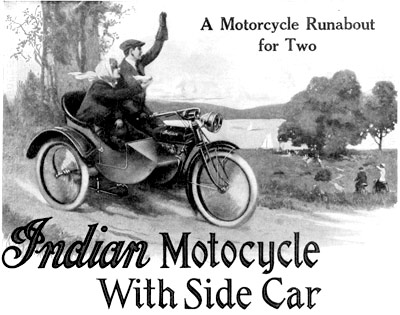
“Indian Motorcycle With Side Car Ad”
from May 9, 1914
This 1914 ad shows that bikes were not just for work. The ad says this motorcycle with sidecar has all the touring comfort and efficiency of an automobile at the cost of trolley fares.
“A spin on a summer’s evening. A weekend trip. A coast-to-coast tour,” the ad rhapsodizes. Well, I don’t see that last one happening on 1914 roads, but we get the idea.
“Yale Bike Ad” – November 2, 1907
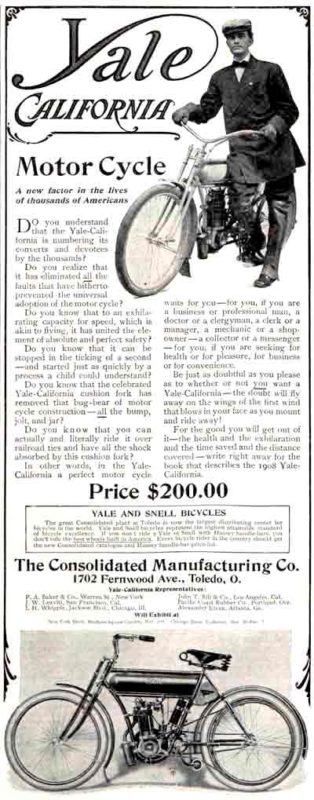
“Yale Bike Ad”
from November 2, 1907
The first motorcycle ads in the Post appeared in 1907—105 years ago! This ad appeared in November of that year for a 1908 Yale California advertised for $200. It is difficult to imagine how many folks could afford that kind of outlay, which would be around $5,000 in today’s dollars.
“Tex’s Motorcycle” by Stevan Dohanos
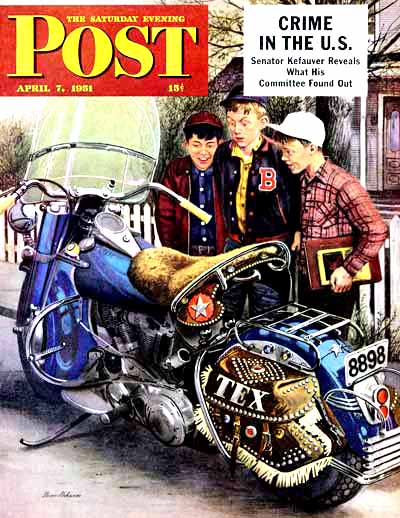
“Tex’s Motorcycle”
by Stevan Dohanos
from April 7, 1951
We showed this cover last year in a piece about illustrator Stevan Dohanos. See more of his work in The Great Covers of Stevan Dohanos.
Mil Blair, an expert at bike building, restored the Harley-Davidson. Blair saw the bike on the Post cover when he was 11 years old and fell in love with it, undoubtedly like every other boy who saw that issue. But wait until you see it today!
“Tex’s Motorcycle”
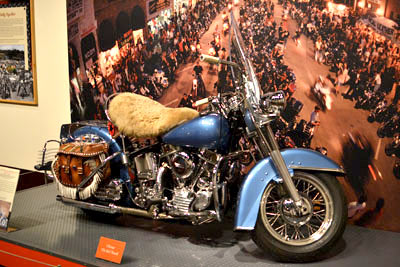
Photo by Dwight Lamb of The Saturday Evening Post
What are the chances of a long-time staffer for The Saturday Evening Post running across a motorcycle made famous by that 1951 Post cover…literally right down the street? The Post’s Dwight Lamb is a frequent visitor to the beautiful Eiteljorg Museum in Indianapolis. Although the Eiteljorg is known for a superb collection of Indian and Western art, the museum was having a display of classic, outlandish or otherwise unique motorcycles. Lamb was stunned when he turned a corner and saw this big, blue…and oddly familiar bike. And yes, motorcycle buffs, Mil Blair, who restored this beauty, rode this classic to the annual Sturgis Motorcycle Rally.
Acknowledgements:
- The history of motorcycle companies like Harley-Davidson are available online and are interesting even if you’re not a motorcycle buff! Click here for the history of the Indian Motorcycle.
- A special thank you to Dwight Lamb, who rediscovered and photographed our big, beautiful Harley.
Classic Covers: A Summer Wedding
“Practice Proposal” by Frederic Stanley
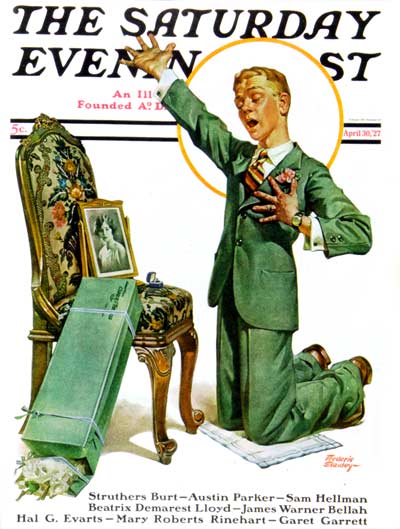
"Practice Proposal"
from April 30, 1927
It all begins here. Artist Frederic Stanley (1892-1967) was great with facial expressions. Nice detail on the floral chair upon which sits a photo of his beloved and the ring at the ready. Like Rockwell, Frederic Stanley used locals for his models: Vermont clerks, housewives, schoolchildren. Between 1921 and 1935, Stanley illustrated 17 Post covers. The “Practice Proposal” is from 1927.
“Icing the Wedding Cake” by Stevan Dohanos
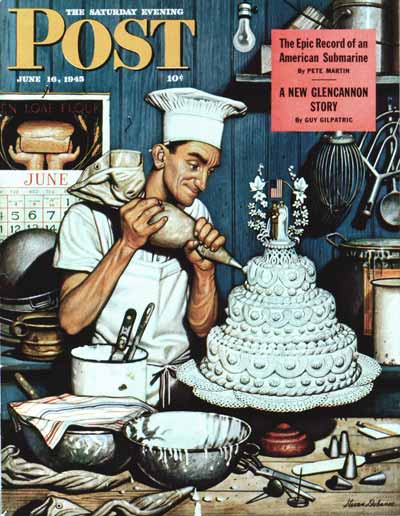
"Icing the Wedding Cake"
from June 16, 1945
If you’re studied the art of Stevan Dohanos, you know he was all about realism. For this 1945 cover, he enlisted the help of a baker in Westport, Connecticut, one Mr. Gus Volkening. The star baker produced this ornate delicacy for our artist to paint. What does an artist do with such a prop once the painting is complete? Well, normally, he would just eat it, but this was just too lavish. So Dohanos called the marriage license bureau and found that a certain Private Stall was due to wed his sweetheart, Lucia, so the happy couple was even happier to receive a wedding cake so beautiful it appeared on the cover of The Saturday Evening Post.
“Wedding March” by Norman Rockwell
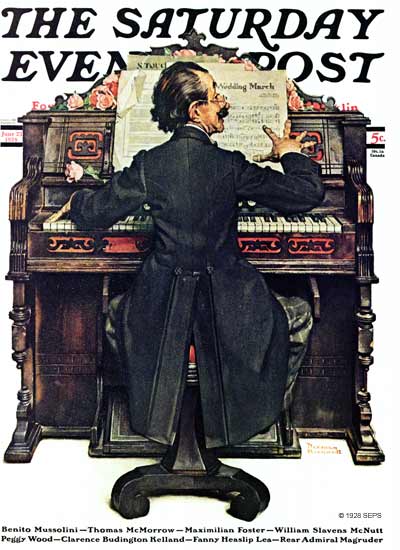
"Wedding March"
from June 23, 1928
One of Norman Rockwell’s most ubiquitous models, James K. Van Brundt makes a charming organist in this 1928 cover. “The day he showed up at my studio,” said the artist, “was one of the luckiest days of my life. ’James K. Van Brunt, sir,’ he said saluting me and bowing all at once. ‘Five feet two inches tall, sir. The exact height of Napoleon Bonaparte.’” Rockwell adored that mustache. “Eight full inches wide from tip to tip,” the little man boasted. “The ladies, Sir, Make much of it.” Rockwell painted him as a hobo, a colonial sign painter, a sentimental cowboy listening to old records and even as gossiping old maids.
“Patient Groom” by E.M. Jackson
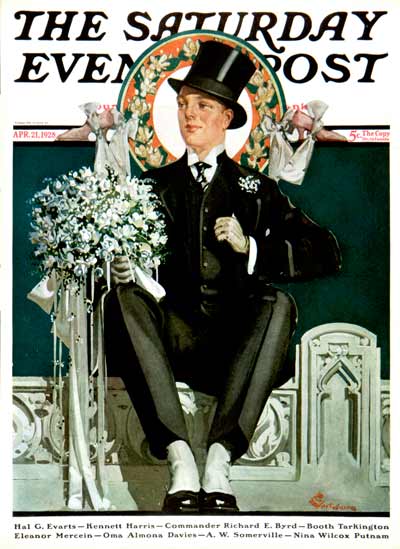
"Patient Groom"
from April 21, 1928
It’s nice to see the emphasis on the handsome groom in this 1928 cover by E.M. Jackson. Jackson’s nearly 50 Saturday Evening Post covers showed influences from prominent artists of the time. Some of his work was very much like that of Norman Rockwell, and several of his covers, like our groom here, resembled the lavish and elegant detail of J.C. Leyendecker.
“There Goes the Bride” by Alan Foster
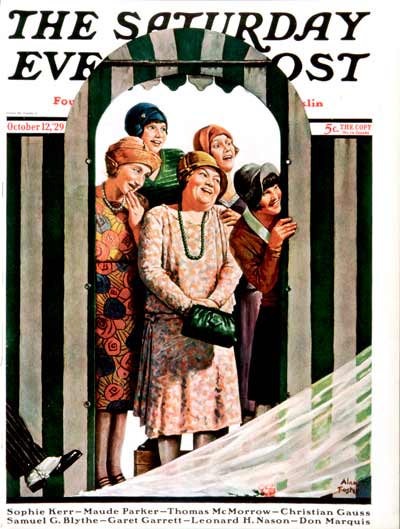
"There Goes the Bride"
from October 12,1929
Of the dozens of covers depicting weddings, this has to be the most unusual. The focus is on the delighted faces of the guests. The bride, except for a bit of her train, is left to the imagination of the viewer, but from the expressions of the observers here, she must be beautiful indeed. And what of the groom? We see only a shoe with spat, and a bit of striped pants leg.
The artist, Alan Foster, did over 30 light-hearted Post covers, several of which we will see in an upcoming feature, “The Fun Covers of Alan Foster.”
“Wedding Reception” by Ben Kimberly Prins

"Wedding Reception"
from June 9, 1962
One can only imagine the work that went into an illustration like this by Holland-born artist Ben Prins (1902-1980). The locale was a Vermont country club, and the guests were “borrowed” from a local wedding. All were happy to cooperate with the artist, and by the time this cover appeared on newsstands, the bride and groom were back to real life; he working in a bank and she as an assistant librarian.
Alas, this is one of the last covers painted by our wonderful stable of illustrators, as photographs of everyone from models to world leaders took over in the 60s.
Classic Covers: The Grocery Store
Remember turning in pop bottles for change? How about having a few cents for candy and taking forever to decide? These Post covers remind us how much shopping has changed.
Lunchtime at the Grocery by Albert W. Hampson
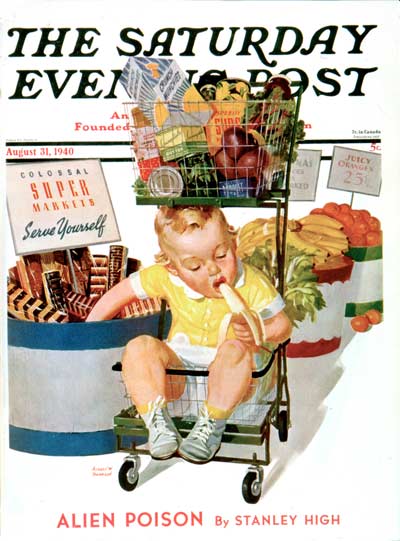
Lunchtime at the Grocery
from August 31, 1940
The grocery cart was only a 3-year-old invention when this 1940 Post cover was painted. Invented in 1937, the “double basket” didn’t immediately catch on. People were used to carrying a woven basket, but to some women the cart seemed a bit much. Older people were afraid they’d appear feeble and men wanted to appear manly, as if handling a few groceries were no big deal. The inventor of the cart, Sylvan Goldman, finally hired models of all ages and both sexes to use the carts while shopping. It caught on enough by 1940, that a Saturday Evening Post cover featured the now ubiquitous baskets on wheels.
Thoughtful Shopper by Norman Rockwell
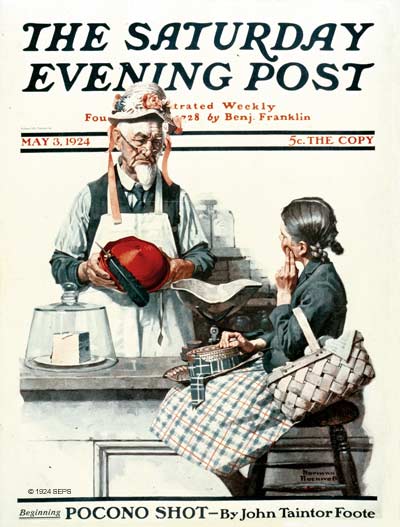
Thoughtful Shopper
May 3, 1924
Before the days of the shopping cart, grocers went around the store fetching items according to your list. According to Norman Rockwell’s 1924 cover, sometimes they had to do so much more. The gentleman in this painting was J. L. Malone, who appeared in at least one other Rockwell cover. The artist appreciated Malone’s reading voice and the model sometimes read aloud for hours while Rockwell worked on an illustration such as this. The usual fare? Classic Dickens.
Penny Candy by Frances Tipton Hunter
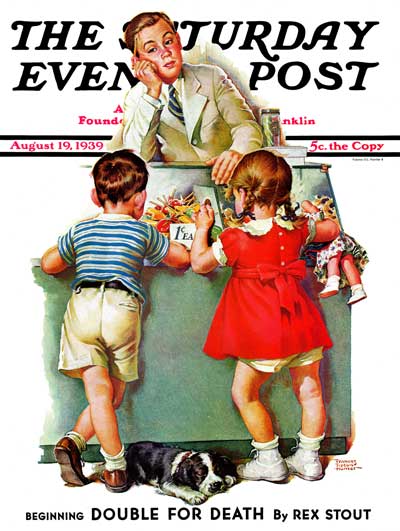
Penny Candy
August 19, 1939
No one promised the grocer an exciting career. Even the dog has fallen asleep while the children try to decide which candy to get. In 1939, a penny was a lot to a little kid. For more covers by Frances Tipton Hunter — guaranteed sweeter than penny candy — see The Art of Frances Tipton Hunter.
Grocery Line by Stevan Dohanos
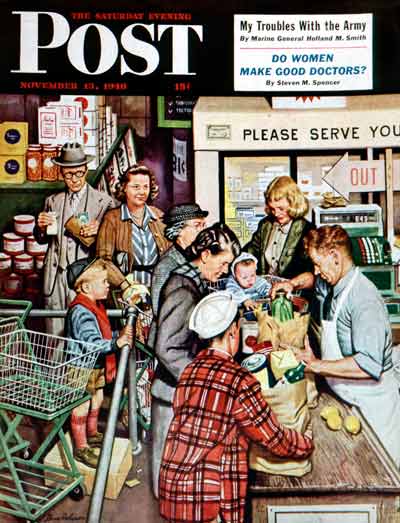
Grocery Line
November 13,1948
As sure as you just want to pay a bite to eat and get on with your day, a slow-moving line looms ahead. Artist Stevan Dohanos had everything he needed in this painting except for just the right guy to portray the stalled shopper. To heck with it; the artist just went ahead with his summer vacation in Martha’s Vineyard. There he spotted a fellow vacationer in shorts and a fishing hat, yelled, “Hey, wait!” and proceeded to explain his Saturday Evening Post cover predicament. Sure, I’ll pose, the stranger said, and headed home to put on his city clothes. The man, H.R. Knickerbocker, was already known as an illustrious war correspondent, but now he was immortalized on a Post cover. The shopping carts are unique, quite different from the below cover from three years later.
More Money, Honey by George Hughes
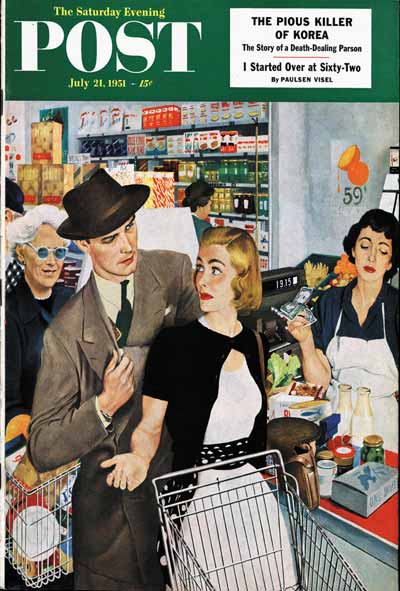
More Money, Honey
July 21, 1951
This 1951 cover with the sleek metal cart looks more like today’s groceries, except perhaps for the milk bottles and the gentleman’s fedora. Oh, and the fact that she’s using a strange thing called cash rather than a credit or debit card.
Babies and Bananas by Stevan Dohanos
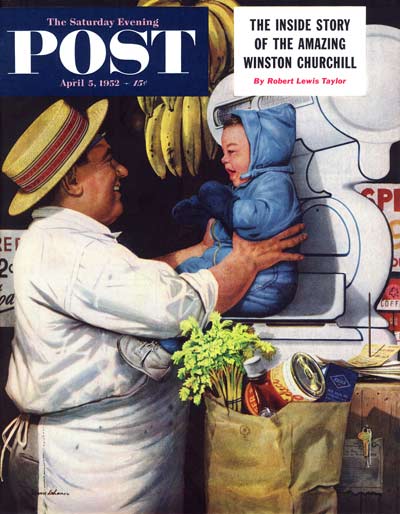
Babies and Bananas
April 5, 1952
This is not an example of how a grocery store operates these days, but this 1952 cover is a fine example of why artist Stevan Dohanos is a Post favorite. Dohanos had done some farm scene murals for the grocery store and decided to use the actual grocer in a painting destined for The Saturday Evening Post. The artist just happened to have a cute baby to use for the cover — his own little tyke, Tony.
Classic Covers: April Showers
“April Showers” by J.C. Leyendecker
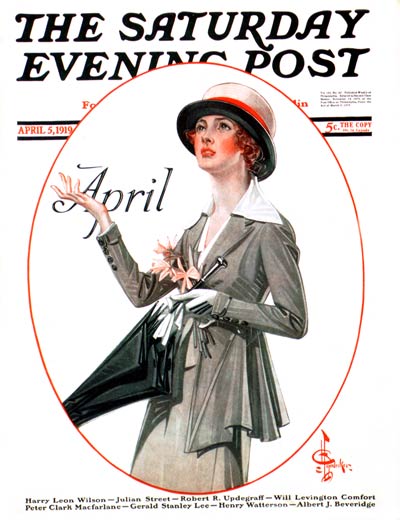
April 5, 1919
This 1919 cover shows a lady prepared for a downpour, but not everyone is ready for the worst.
“Baseball Rained Out” by Charles A. MacLellan

August 4, 1917
Game called on account of wetness. The artist, Charles A. MacLellan, did almost fifty Saturday Evening Post covers and this 1917 one is a treat.
“Commuters in the Rain” by John Falter
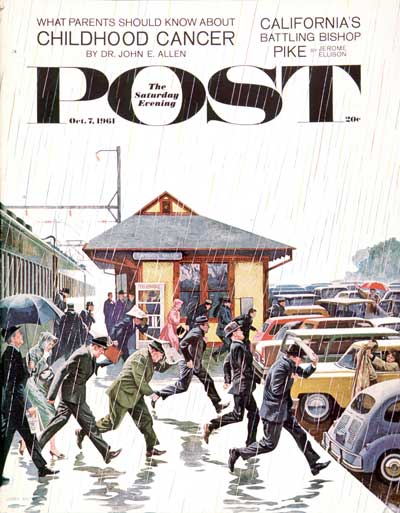
Making a run for it in 1961 are these commuters rushing from the train. Why does the rain on the plains fall mainly when we detrain? This was by one of our favorite cover artists, John Falter, who cheated: he painted the railroad station in Gynedd Valley, PA while it was sunny and dry.
“Cub Scouts in Phone Booth” by Richard Sargent
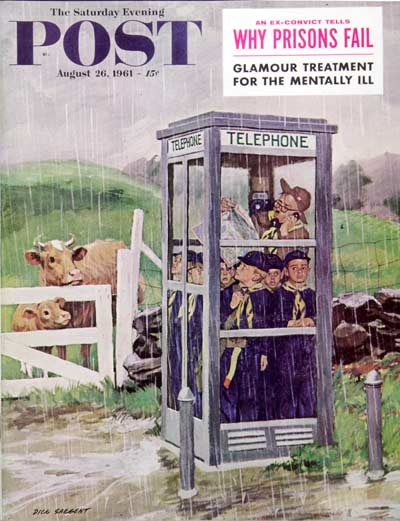
August 26, 1961
Somehow on their country hike, these Cub Scouts were able to use their tracking skills to find a phone booth. “We realize this is an awfully small Cub pack,” Post editors wrote, “but artist Dick Sargent simply couldn’t pack any more boys into the booth.” Good luck finding a phone booth these days, but this cover was from 1961.
“Flat Tire, Flat Evening” by Ellen Pyle
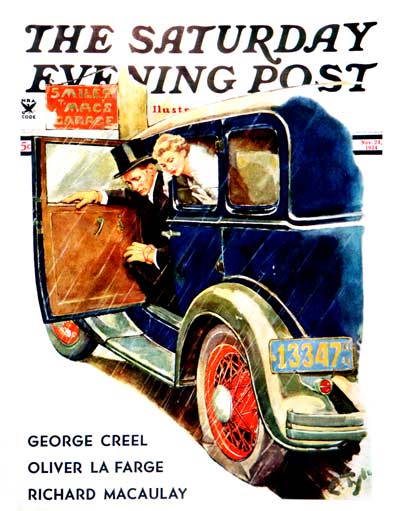
November 24, 1934
It’s raining, you are in formal wear, and a tire goes flat – anything else? Oh yes, the nearest garage is five miles away. This 1934 cover is a unique one for delightful artist Ellen Pyle; most of her Post covers were of adorable children or young ladies.
“Splashed” by John LaGatta
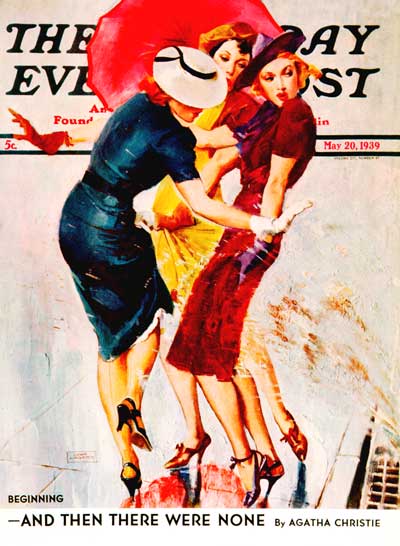
May 20, 1939
Stylish, willowy ladies and gorgeous colors – it must be the work of artist John LaGatta. But as we learned from the cover above, being elegantly attired tempts fate. What can be more of an affront than looking urbane and polished and getting splashed by a passing car? We have an answer below. (See more of The Elegant Art of John LaGatta.)
“Muddied by Dry Cleaning Truck” by Stevan Dohanos
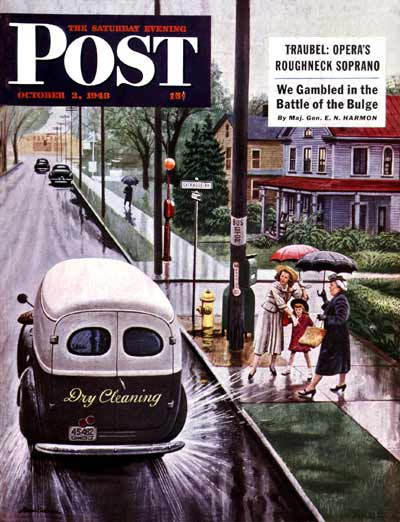
October 2, 1948
Adding insult to wetness, these pedestrians are getting soiled by, what else? A dry-cleaning truck. Ever the realist, artist Stevan Dohanos followed delivery trucks around Bridgeport, Connecticut for a while in order to study “splash detail.” Once he got the technique, that twisted humor that afflicted so many of our fine cover artists kicked in and he decided to paint a truck delivering clean laundry. We’re sure it was a driver oversight and not an attempt to drum up business. For more wonderful art by this artist, see “The Great Covers of Stevan Dohanos.”
